
- All topics A-Z
- Grammar
- Vocabulary
- Speaking
- Reading
- Listening
- Writing
- Pronunciation
- Virtual Classroom
- Worksheets by season
- 600 Creative Writing Prompts
- Warmers, fillers & ice-breakers
- Coloring pages to print
- Flashcards
- Classroom management worksheets
- Emergency worksheets
- Revision worksheets
- Resources we recommend

FREE Feelings and Emotions Worksheets
Welcome to the feelings and emotions section of the site. there are currently 301 worksheets available on this topic; they are free and easy to print out to use in your classroom. this feelings & emotions worksheet uses an amusing character to illustrate thirty different emotions. you can use this as an introduction, a study sheet, a poster, and even adapt it to make your own matching worksheet to help test students on basic feelings. if this is not what you are looking for, browse the section for something more suitable for your students. you are encouraged to rate and leave comments for the worksheets you use and can even upload your own worksheets for other teachers to try out. feelings and emotions are very difficult to express in a non-native language. help students talk about their feelings by introducing common phrases and giving them the opportunity to practice using them. if your students all respond “i’m fine, thank you.” to the question “how are you” encourage them to use other vocabulary words to be more specific. your class before lunch might start to rely on “hungry” which is not an emotional but a physical state while the last class of the day might always be “tired” so give them practice activities that let them think about other occasions. “how do you feel in the morning” or “how do you feel on your birthday” type questions will allow students to think of different responses. read more... ...less.
- Copyright 2007-2021 пїЅ
- Submit a worksheet
- Mobile version
- Skip to main content
- Skip to primary sidebar
Fun with Mama
Toddler and preschool activities
Written by Nadia T • Feb 12, 2024 • Leave a Comment
Feelings Activities + Emotions Worksheets For Kids
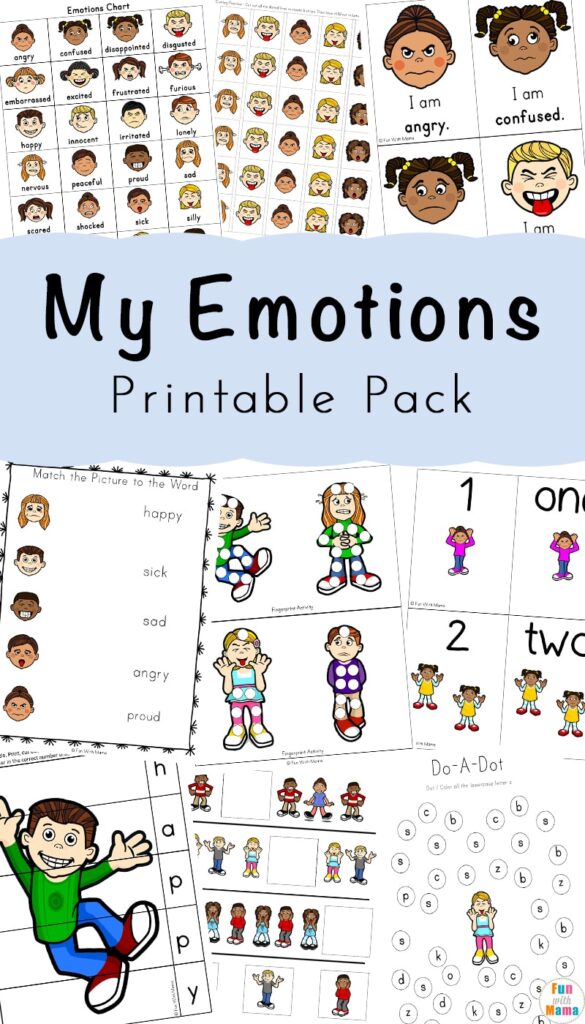
Are you teaching feelings? Understanding feelings and emotions for kids is an important social skill. In this feelings activities for kids preschool printable pack, children will learn vocabulary words to label their emotions and, in turn, hopefully, learn to work through their emotions and feelings.
The printable emotion chart includes faces of different emotions so children will notice the different facial expressions and what they mean.
There are also emotion cards, emotions worksheets, teaching feeling game and more!
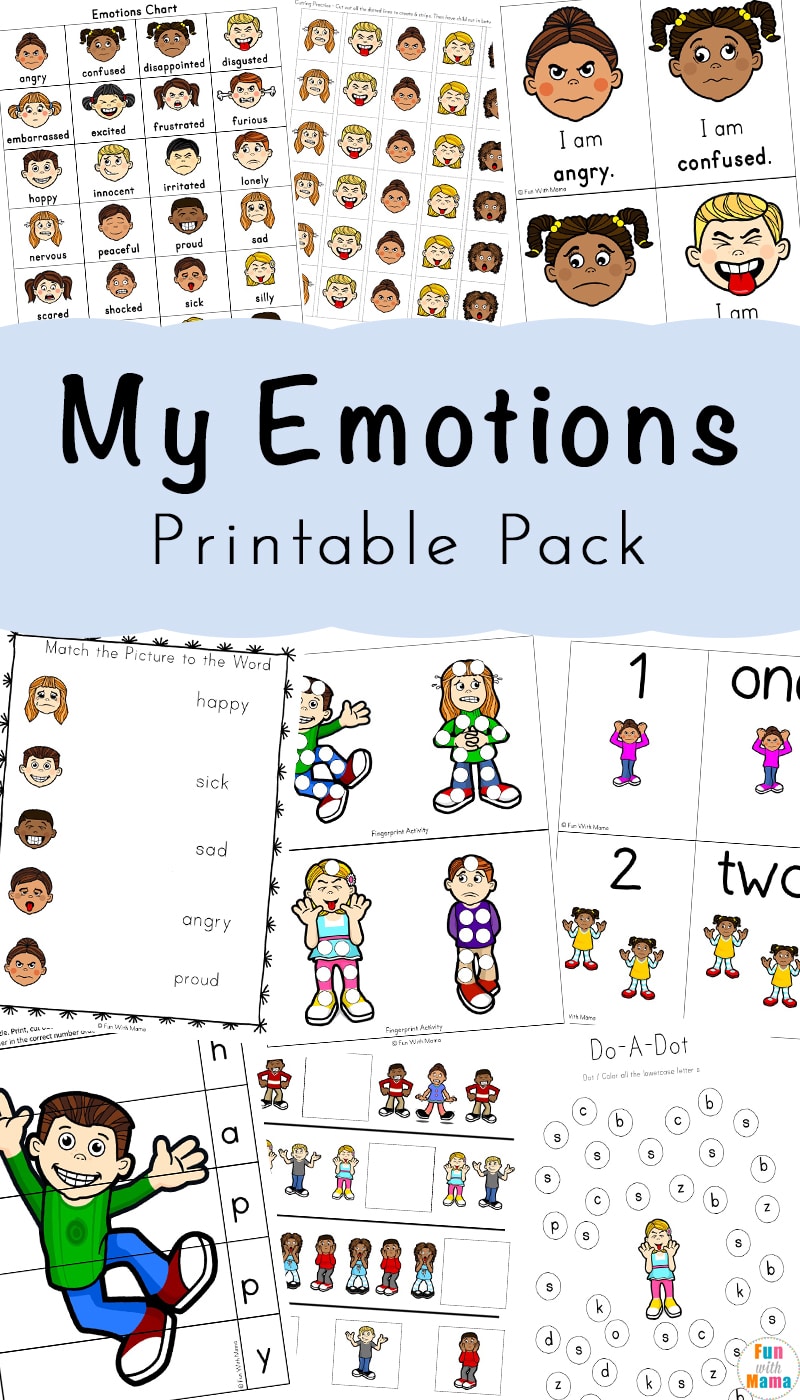
Feelings and emotions
This Emotion Printable Pack is aimed at children in preschool and kindergarten. It includes a variety of math and literacy activities as well as emotion-focused activities. You can add these books about feelings for kids to encourage more talk about emotions. The Friendship and Feelings Koala Crate also goes well with these themed preschool activities.
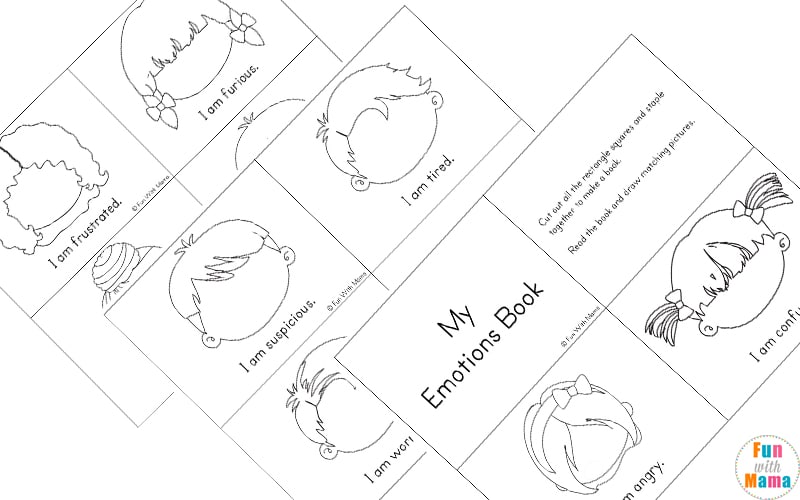
Materials Required:
Here are some items that pair well with these activities. You will use each of these items over and over during all my printable preschool activity packs.
- Do a Dot Art Markers
- Card stock (to print everything out on.)
- A pocket chart
- Write and wipe Dry Erase Pockets
- Laminator with pockets (If you want to make it reusable.)
- Clothespins (for the clip cards)
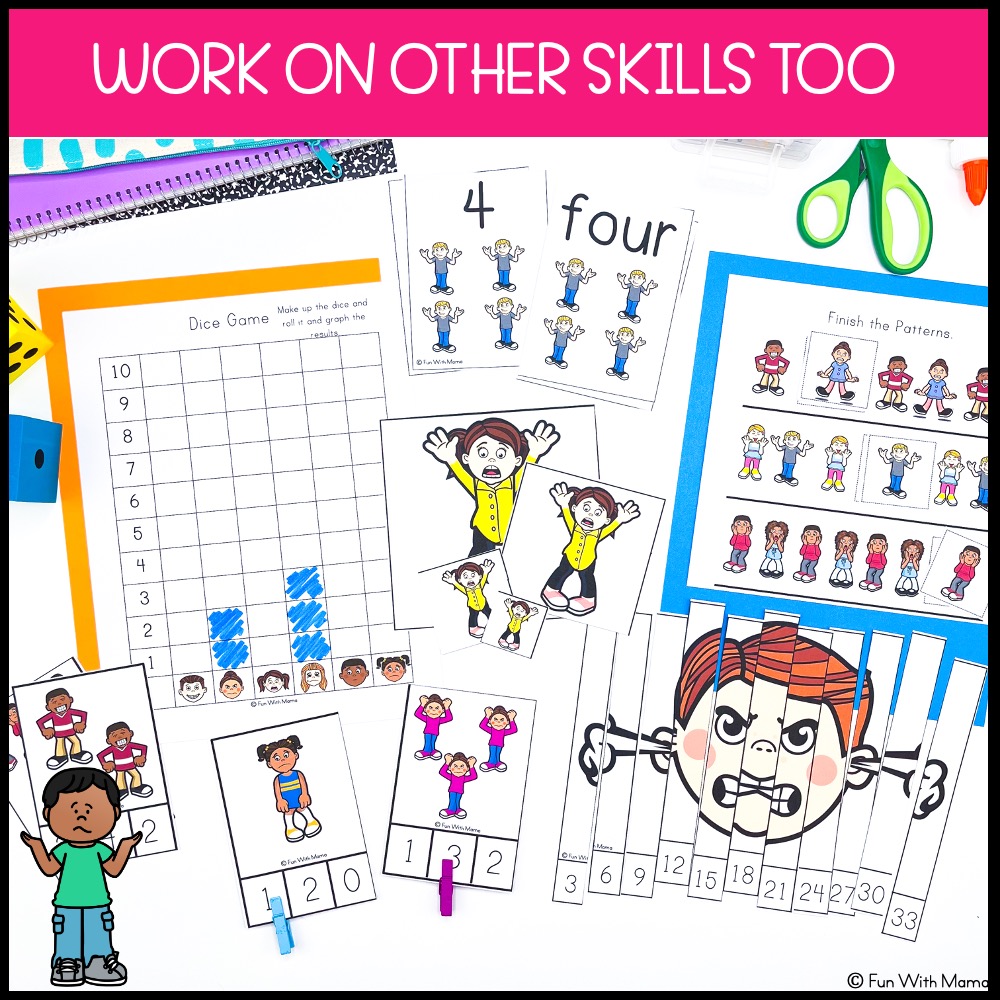
Emotions For Kids
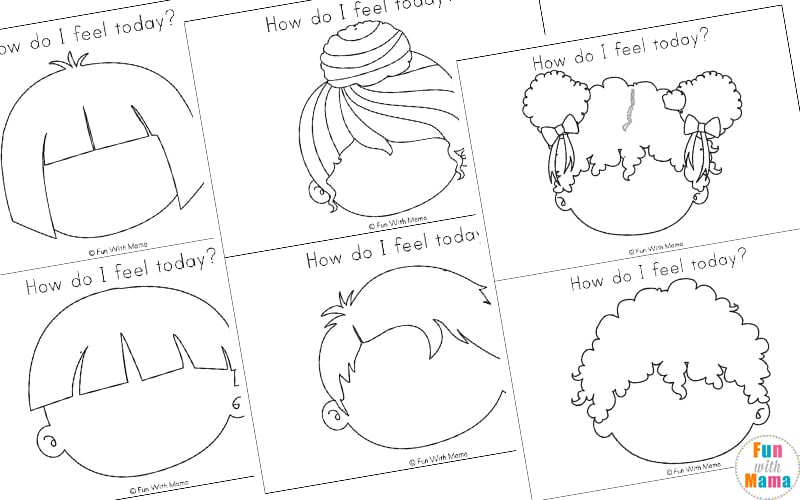
Feelings Activities
At the beginning of this Feelings and Emotions Printable Pack is an emotions chart. This would be great printed on white cardstock and then laminated. Children can review this chart when needed to help them understand and control their emotions.
Also included are some Emotions flashcards. These would be great laminated too. They could be used in many ways such as:
- Helping children understand their emotions
- Helping children share how they are feeling
- Spelling the different types of emotions
- Learning facial expressions that relate to each emotion
- Matching / Memory Games when two copies are printed
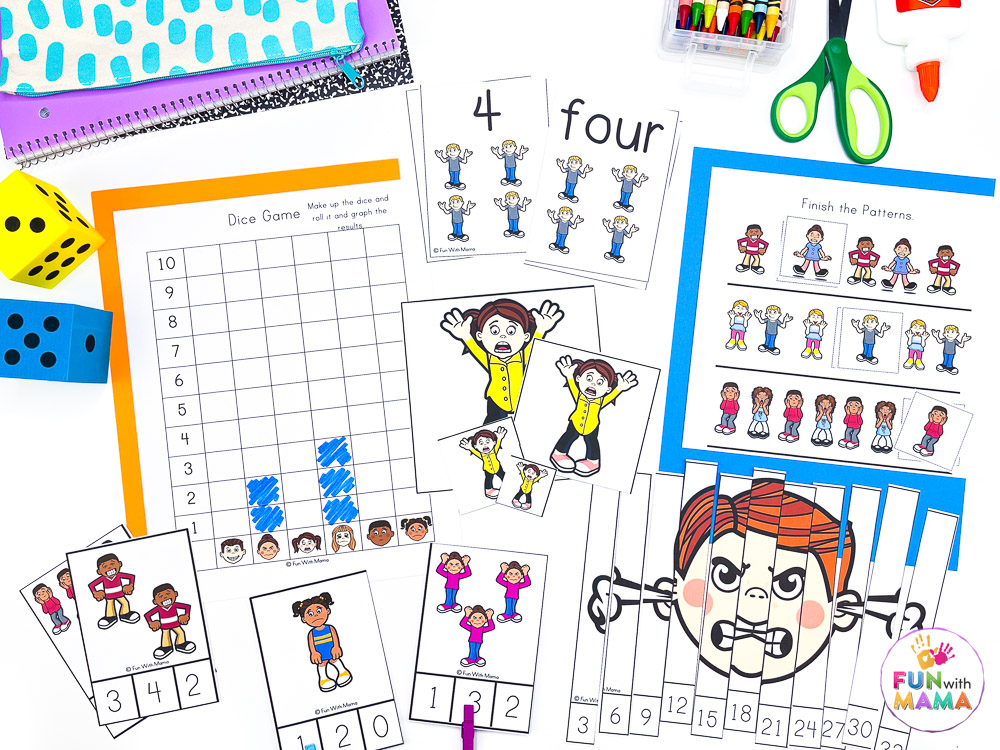
The emotion chart includes a way for children to describe how they are feeling today. This emotions chart helps children put into words how they may be feeling. You can also use it to pose pretend scenarios and ask children how they would feel if such and such happened. “If you forgot your lunch at home how would you feel?” “When you got angry and threw the toys on the floor, how were you feeling?” This is also why using books about feelings is so important for these type of lesson plans for preschoolers. It helps children examples of scenarios where feelings and emotions move around the chart. Check out the 20 Books About Feelings For Kids post. Print a small version of the emotion faces chart for quick reference or to send home with children.
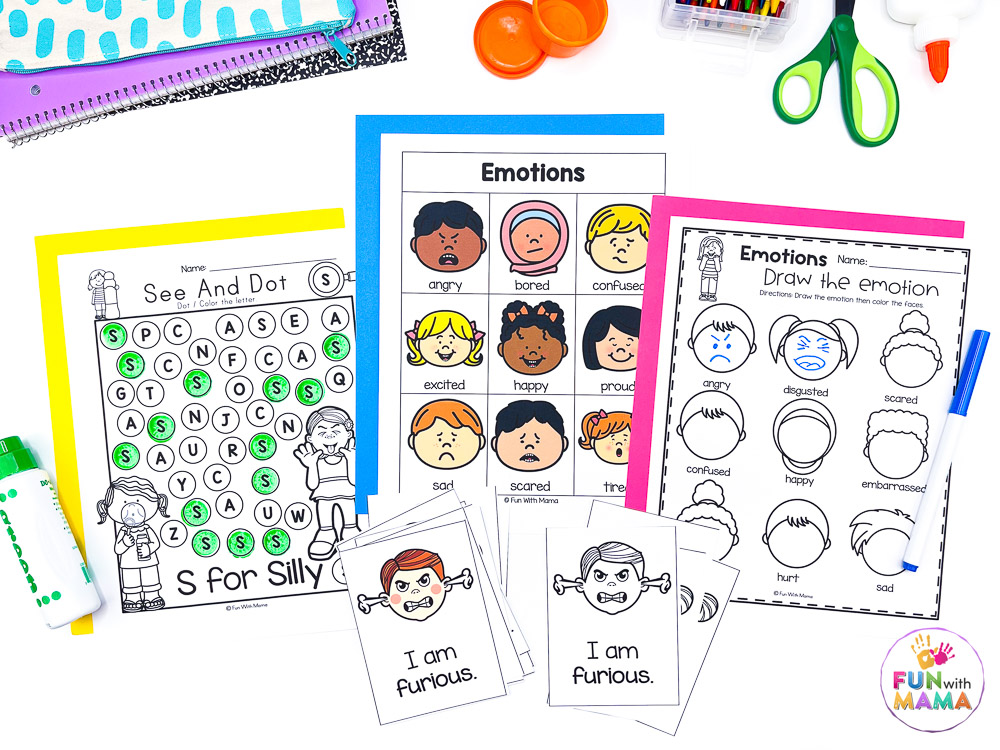
At the end of the pack are some blank faces. There are two faces per page. These pages are great for children to complete to show how they are feeling. They can add the facial expressions as well as color in the pictures. They could also practice writing the name of their emotion next to the face.
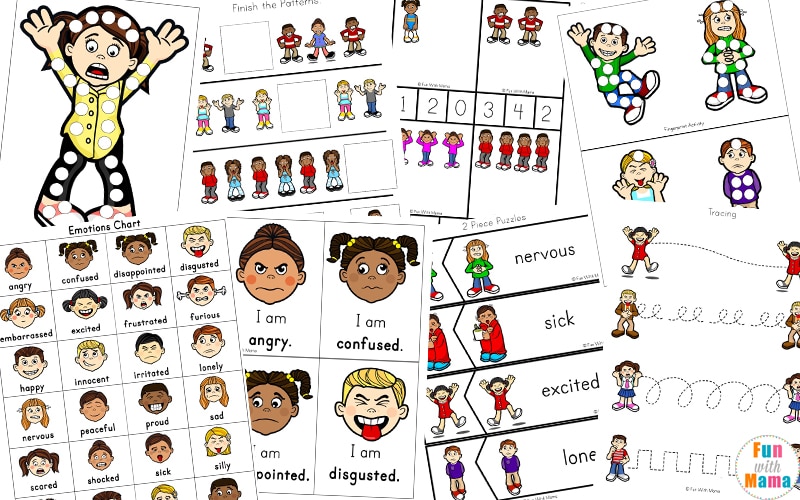
Other activities in this Feelings and Emotions Printable Pack include more exploration of how a child feels. It also encourages children to talk about different ways they can express their emotions. “What does your face look like when you are mad? How do you feel inside when you are angry?”
Emotions Worksheets
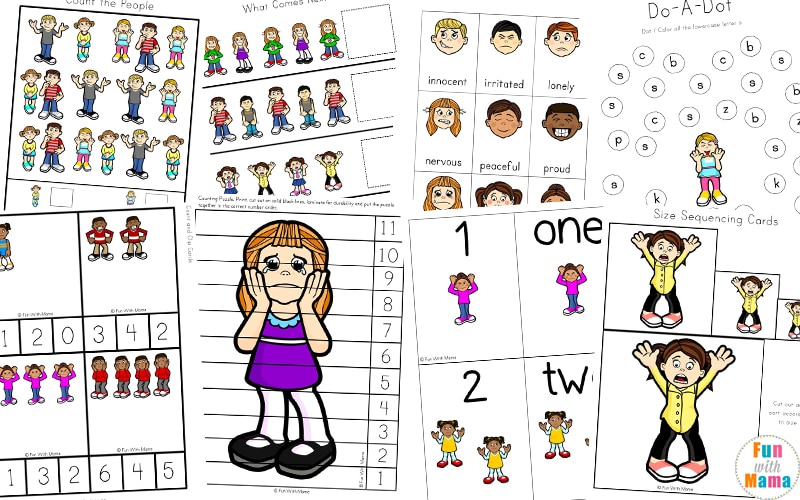
I have included a booklet of blank faces so children can include emotions for kids that they are currently feeling. It is a great activity for when a child is feeling frustrated. By asking them to draw or show them how they feel they are learning to understand their feelings and why they might be feeling emotional. You could print out the 3 part cards above and use them for a game teaching feeling too!
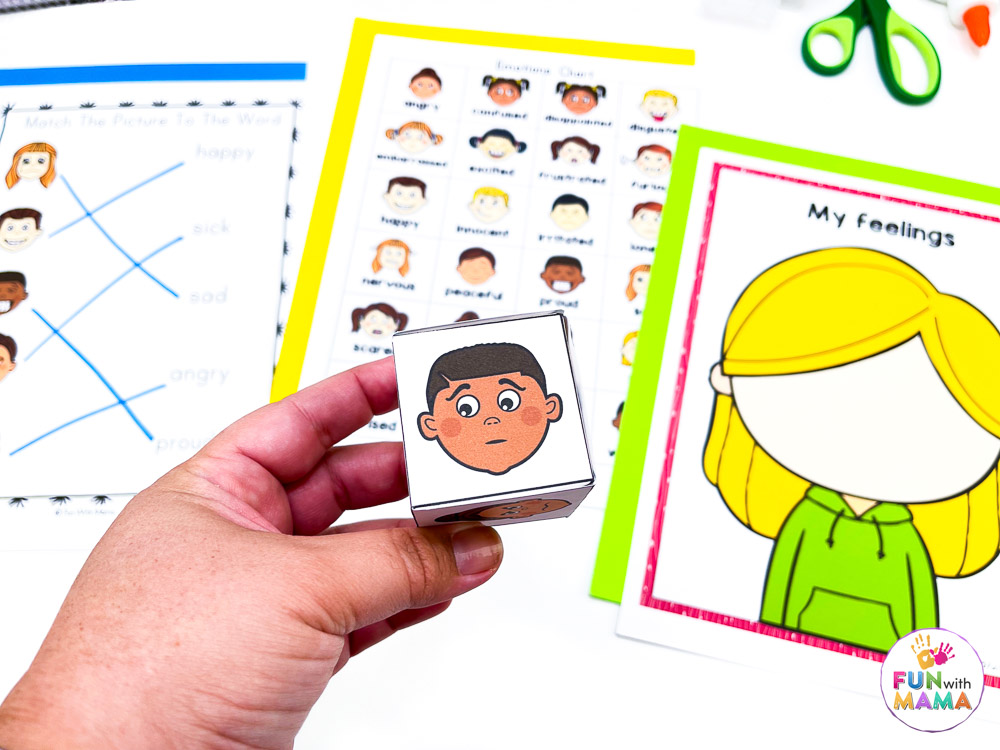
Teaching Feelings Game
Print out 2 copies of the whole 3 part cards on to card stock paper . Play a memory game. Each time someone turns two cards over that is the same emotion, they get to keep the matching cards. There are also a variety of activities and teaching feeling games you can create when using the cards found within the pack.
WHERE TO GET THE ACTIVITY
Get the feelings and emotions activity pack here.
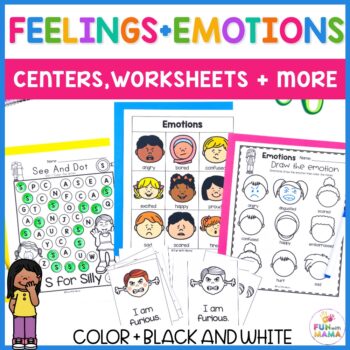
Add this fun Emotions sensory bin to your classroom activities.
Fun With Mama also has another feelings and emotions pack using Emoji’s. Emotions + Shapes Free Printable Preschool Pack
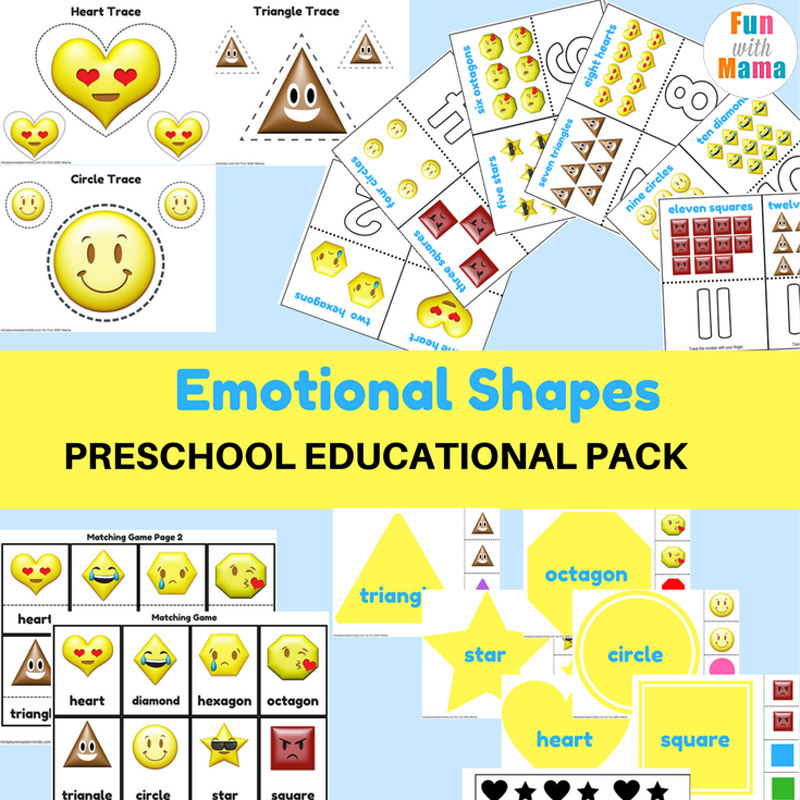
Nadia is a mom of 4, with a passion for making childhood education fun through play. She encourages parents to spend quality time with their kids through fun kids activities and enjoys art, traveling, and doing activities with her children.
View all posts from this author
You May Also Enjoy These Posts:
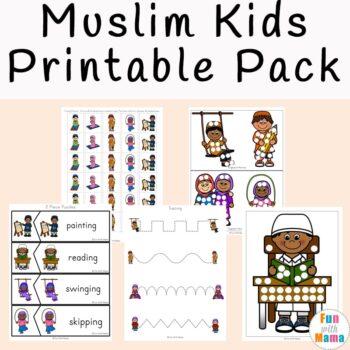
Get easy and instant access to ALL of our printable activities and resources by joining the Fun With Mama printables club.
Get all the details and join here.
Reader Interactions

Leave a Comment Cancel reply
Your email address will not be published. Required fields are marked *
This site uses Akismet to reduce spam. Learn how your comment data is processed .
Have you grabbed the latest FREE printables?
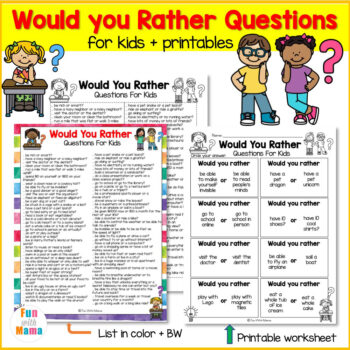

Addition (Basic)
Addition (Multi-Digit)
Algebra & Pre-Algebra
Comparing Numbers
Daily Math Review
Division (Basic)
Division (Long Division)
Hundreds Charts
Measurement
Multiplication (Basic)
Multiplication (Multi-Digit)
Order of Operations
Place Value
Probability
Skip Counting
Subtraction
Telling Time
Word Problems (Daily)
More Math Worksheets
Reading Comprehension
Reading Comprehension Gr. 1
Reading Comprehension Gr. 2
Reading Comprehension Gr. 3
Reading Comprehension Gr. 4
Reading Comprehension Gr. 5
Reading Comprehension Gr. 6
Reading & Writing
Reading Worksheets
Cause & Effect
Fact & Opinion
Fix the Sentences
Graphic Organizers
Synonyms & Antonyms
Writing Prompts
Writing Story Pictures
Writing Worksheets
More ELA Worksheets
Consonant Sounds
Vowel Sounds
Consonant Blends
Consonant Digraphs
Word Families
More Phonics Worksheets
Early Literacy
Build Sentences
Sight Word Units
Sight Words (Individual)
More Early Literacy
Punctuation
Subjects and Predicates
More Grammar Worksheets
Spelling Lists
Spelling Grade 1
Spelling Grade 2
Spelling Grade 3
Spelling Grade 4
Spelling Grade 5
Spelling Grade 6
More Spelling Worksheets
Chapter Books
Charlotte's Web
Magic Tree House #1
Boxcar Children
More Literacy Units
Animal (Vertebrate) Groups
Butterfly Life Cycle
Electricity
Matter (Solid, Liquid, Gas)
Simple Machines
Space - Solar System
More Science Worksheets
Social Studies
Maps (Geography)
Maps (Map Skills)
More Social Studies
Mother's Day
Father's Day
More Holiday Worksheets
Puzzles & Brain Teasers
Brain Teasers
Logic: Addition Squares
Mystery Graph Pictures
Number Detective
Lost in the USA
More Thinking Puzzles
Teacher Helpers
Teaching Tools
Award Certificates
More Teacher Helpers
Pre-K and Kindergarten
Alphabet (ABCs)
Numbers and Counting
Shapes (Basic)
More Kindergarten
Worksheet Generator
Word Search Generator
Multiple Choice Generator
Fill-in-the-Blanks Generator
More Generator Tools
Full Website Index
Emotions and Feelings Worksheets
Use these printable worksheets and games for teaching students about basic emotions and feelings. Feelings included in these activities: happy, sad, angry, tired, and afraid.
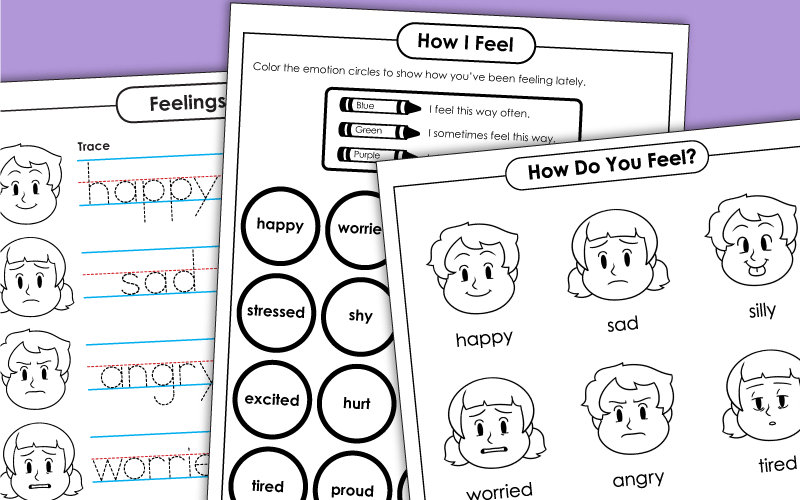
Grades K through 2

Logged in members can use the Super Teacher Worksheets filing cabinet to save their favorite worksheets.
Quickly access your most used files AND your custom generated worksheets!
Please login to your account or become a member and join our community today to utilize this helpful feature.

Grades 3 and Up

On this page, we connect you with worksheets and games on fire safety, Internet safety, bullying, nutrition, and more.
Sample Worksheet Images
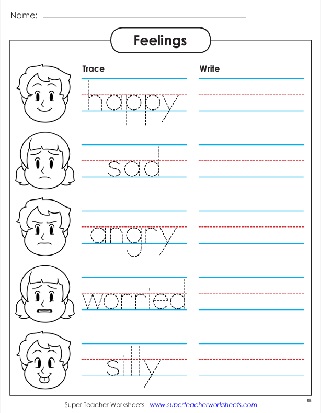
PDF with answer key:
PDF no answer key:

Free Feelings Worksheets
Download free printable feelings worksheets and use them in class today. On this page, you can find a collection of PDF worksheets for teaching feelings and emotions in English. These feelings worksheets are suitable for kids and beginner English language learners. See below for the feelings worksheets currently available, and check the bottom of the page for related resources.
Feelings Worksheets
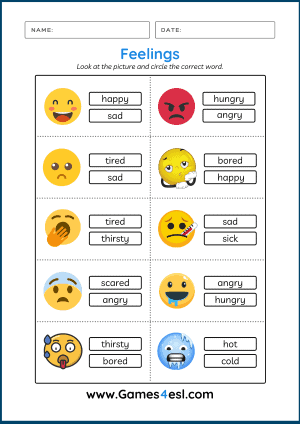
Worksheet 1
This first feelings worksheet is great for introducing the names of feelings and emotions in English. There are 10 feelings on this worksheet including happy, sad, angry, hungry, thirsty, bored, tired, cold, scared, and sick. To complete the worksheet, students should look at the picture and then circle the correct feeling/emotion word.
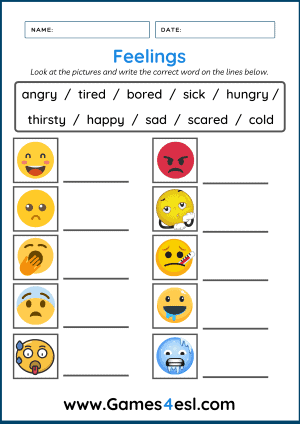
Worksheet 2
This next feelings and emotions worksheet is suitable for kids and beginner ESL students. To complete the worksheet, students should look at the emoticon and then fill in the blank space with the correct feelings word.
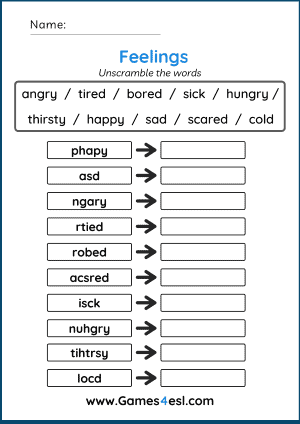
Worksheet 3
This feelings vocabulary worksheet includes 10 words about feelings and emotions in English. To complete the worksheet, students should unscramble the letters and then write the correct feeling in the box provided.

Worksheet 4
This worksheet is a feelings and emotions word search. There are 12 words for students to find. Once they find the words in the grid, students should check off the words at the bottom of the page.
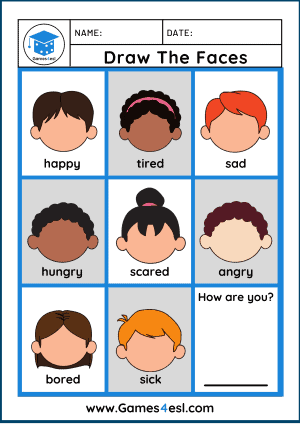
Worksheet 5
This feelings worksheet is a drawing worksheet in which students should draw the feelings/emotions being described on the blank faces. There are 8 blank faces and a blank square for students to draw their own feelings. This worksheet is great for lessons teaching feelings and emotions vocabulary and expressions such as ‘How are you?’
Related Resources
For more lesson materials for teaching about feelings and emotions in English, check out these related resources: Feelings and Emotions Flashcards and Board Games Feelings Guessing Game Feelings Vocabulary Exercises Feelings and Emotions PowerPoint Lesson
- Breastfeeding Tips
- Baby & Toddler
- Activities For Kids
- Travel Gear
- Travel Gifts
- Travel Tips
- North America
- South America
Printable Emotions Worksheets For Kids
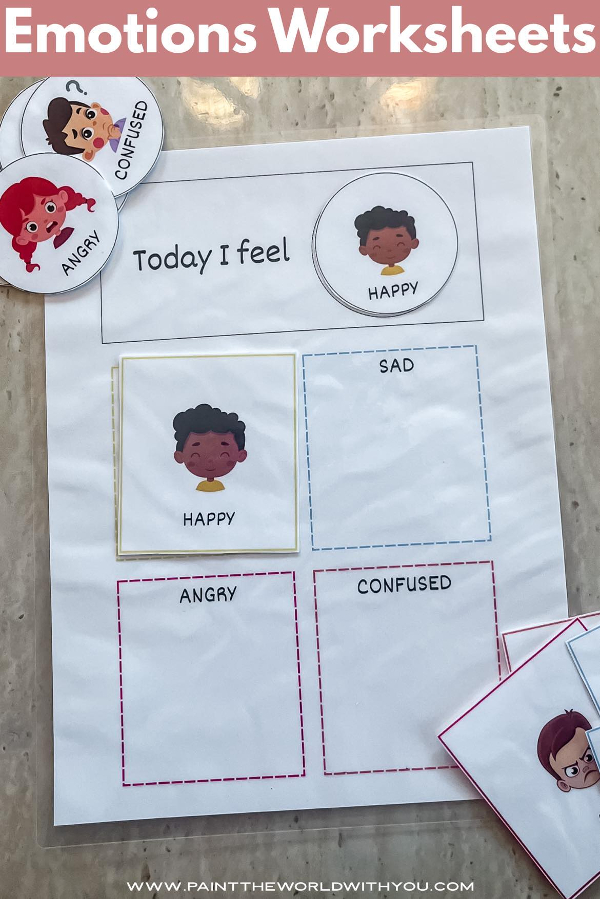
In today’s fast-paced and often overwhelming world, it is essential to equip children with the emotional intelligence skills to navigate their feelings. Emotions worksheets can be an extremely valuable tool in promoting self-awareness, empathy, and resilience in our little ones. The beauty of printable emotions worksheets designed for kids, parents, and educators is that it’s an instant resource to guide children through identifying, understanding, and expressing their emotions.
Let’s help our little ones get out their inner emotions with these feelings and emotions worksheets pdf that are sure to make learning a whole lot more fun! We all know that kids can be a rollercoaster of feelings, swinging from joy to frustration in a matter of seconds. I will tell you I’ve learned the hard way by not giving enough choices in almost any and everything.
This is a printable Emotions Social Story Kit that is an interactive activity to allow them to identify and explore emotions. These are perfect emotions worksheets for kindergarten and preschoolers. It can be hard for them to express themselves at this age.
They just might have your little ones giggling at the characters and thinking is that me? LOL. Whether they’re feeling happy, sad, or hangry (yes, it’s a legit emotion), these emotions printable worksheets are here to teach them about their feelings while keeping boredom at bay. So grab your scissors, velcro dots and get ready to dive into the colorful world of emotions–let the emotional exploration begin!
Related: Fun Kids Role Play Ideas
Table of Contents
Different Emotions Kids Experience
From the highest highs to the lowest lows, children experience a whole spectrum of feelings that can leave even adults scratching their heads. While sometimes it might feel confusing or overwhelming, understanding and embracing our emotions is an essential part of growing up.
1. Happiness – The Warm Glow Inside: It’s like finding a pot of gold at the end of a rainbow. Remember those moments when your favorite ice cream flavor makes your taste buds dance with joy? Or when you finally conquer that tricky video game level? That feeling is pure happiness! It fills us up with warmth and brings smiles to our faces.
2. Excitement – Ready, Set, Go! Imagine waking up on your birthday morning or hearing about an upcoming adventure-filled vacation–that bubbling sensation inside you is excitement! You can find it in trying something new or receiving good news. Excitement makes life thrilling and gives us butterflies in our tummies. This emotion knows no bounds. Buckle up parents; excitement can only be contained by releasing it through enthusiastic dancing, squealing, and rapid-fire questions. At least this is what happens in my house.
3. Sadness – The Rainy Clouds Above: Sadness can feel like rain clouds hovering over our heads. Maybe you miss a friend who moved away or had to say goodbye to your pet; these experiences can bring tears to our eyes and make us feel blue. But remember, it’s okay to be sad sometimes because this emotion teaches us empathy and resilience.
4. Anger – Flames That Need Taming: Anger can be fiery hot like dragon breath but also powerful if used wisely! When things don’t go as planned or someone accidentally breaks our favorite toy, anger might flare up inside us. But take deep breaths and count to ten before reacting impulsively–anger helps us learn how to communicate meaningfully and solve problems peacefully.
5. Fear – Conquering the Monsters: Boo! Fear is like a monster hiding under our beds, but we can face it bravely. That sneaky emotion that creeps up on kids when they least expect it. They might be feeling scared of the dark or encountering new situations that make them nervous. Remember, fear helps us stay safe and teaches us to be cautious while exploring the world around us.
6. Love – Heartwarming Hugs: Love is all about those heart-melting moments when you feel as warm as a cup of cocoa.
7. Confusion – All mixed up: Those maybe so, maybe not feelings. I want it but I don’t because I want something else even more. Their thoughts feel completely jumbled and mixed up.
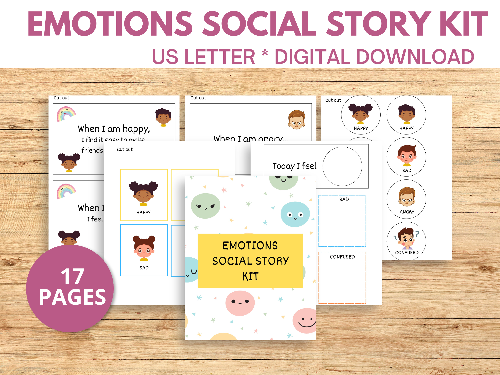
This is an interactive Emotions Social Story Kit with colorful and fun characters to express each emotion.
What’s included:
- (17) pages to include the cover page.
- How do you feel worksheet-on this sheet they can add a character expressing the emotion.
- (3) pages of character icons representing happy, sad, angry, and confused with both girl and boy options.
- (12) pages of coping cards. For beginner readers or read to those who cannot read them. For kids that can read they can keep them in a safe place and read them as needed.
What you’ll need:
- You’ll need a printer or you can have your emotions sheets printed at a print shop like Office Depot/Max .
- Laminate each sheet for long-term use.
- A pair of scissors to cut out your icons and coping cards.
- Velcro dots .
After cutting out icons, I like to keep them in a sturdy pouch that also provides easy access.
Related: Imagination Play Ideas For Toddlers
Benefits of Helping Children Understand And Identify Their Emotions
Helping children understand and identify their feelings is like unlocking a superpower.
1. Building Emotional Intelligence : Just like learning to read or ride a bike, understanding emotions is an essential life skill for our little ones. By helping our kids with their emotions early on, we equip them with emotional intelligence that will help them throughout their lives. It will help them navigate social relationships, communicate effectively, manage stress, and make better decisions.
2. Enhancing Self-Awareness : Understanding emotions allows kids to develop self-awareness–the ability to recognize their own feelings as they arise. This superpower enables them to better understand why they feel a certain way, laying a foundation for increased self-control and empathy toward others. I’m learning as they grow, self-awareness is major in setting personal boundaries and understanding personal strengths.
3. Strengthening Communication Skills : Imagine if everyone had mastered expressing their emotions clearly from an early age – what an incredible world it would be, right? Often than not kids who can effectively identify their feelings are more likely to express themselves openly.
4. Developing Coping Mechanisms : Life isn’t always rainbows; sometimes thunderstorms roll in too! When children understand how different emotions manifest within themselves, it becomes easier for us grown-ups to help them build healthy coping mechanisms when faced with challenges or disappointments.
5. Nurturing Empathy and Social Skills: Understanding emotions isn’t just about ourselves; it’s also about developing empathy towards others. When children can identify and relate to their own feelings, they’re better prepared to recognize similar emotions in their peers.
Related: Creative Summer Preschool Worksheets
How Emotions Worksheets Help Kids
- Identify and understand different emotions: Emotions worksheets can help kids learn to recognize and label various emotions such as happiness, sadness, anger, fear, and surprise.
- Worksheets can help build self-awareness by helping children understand the causes and effects of different emotions and how to manage them effectively.
- Emotions worksheets allow children to reflect on their own feelings and gain a better understanding of themselves.
- By using feelings worksheets, kids can learn how to express their emotions clearly and effectively, both verbally and non-verbally.
- Reduce impulsivity: This Emotions Social Story Kit comes with coping cards to help children better understand each emotion and develop strategies for alternative ways of dealing with challenging emotions.
- Boost problem-solving skills.
- They can serve as a visual aid to recognize and express feelings.
- Emotions and feelings worksheets provide children with tools for coping with stress or overwhelming feelings in a healthy manner instead of resorting to harmful behaviors like aggression or withdrawal.
- Support overall well-being.
- Promote mindfulness practices.
Related: Interactive 4-Year-Old Chore Chart
Tips for Using Emotion Identification Worksheets with Kids
In the Print It Mo shop , as mentioned above you’ll find a story kit that is focused on emotion identification. They focus on helping kids recognize different emotions by providing visuals including pictures of children expressing specific feelings. It’s an excellent starting point.
1. Create a Safe Space : Before introducing emotion identification worksheets, it’s a good idea to establish a safe and supportive environment where children feel comfortable expressing themselves. Also, encourage open communication by letting them know it’s totally okay to have different emotions at different times.
2. Start with Familiar Emotions : Begin with basic emotions like happiness, sadness, anger, or fear when using these worksheets for the first time.
3. Make It Fun : Remember, learning should always be exciting. Add an element of playfulness by incorporating games or role-playing activities with the worksheet exercises if at all possible.
4. Use Visual Aids : Children often respond well to visual cues; use the illustrations showing various facial expressions associated with each emotion category. It can be especially helpful for younger kids who might struggle with verbalizing their feelings.
5. Discuss Real-Life Scenarios : Connect the worksheet activities to real-life situations so that children can relate better.
6. Foster Empathy : Emotion identification worksheets are an excellent tool for nurturing empathy in children. Engage them in discussions about how different emotions might affect others’ thoughts and actions.
Types of Emotions worksheets
Here are a few other types of emotions worksheets for kids:
- Word searches aren’t just a way to pass the time; they can also be educational. An emotion word search worksheet is a sheet of paper full of letters, hiding words related to different emotions. By finding these words, bigger kids can improve their vocabulary and also become familiar with the language used to describe various feelings.
- Who doesn’t love coloring? Coloring pages combine creativity with emotional exploration. These types featuring different facial expressions give individuals a chance to express themselves creatively while acknowledging and discussing each emotion as they color.
- Feelings Wheel Worksheets: Feelings wheels are circular diagrams with various emotional states arranged in categories such as happy, sad, angry, scared, etc., branching out into more specific sub-emotions (e.g., excited, frustrated). With these worksheets, individuals spin the wheel or select an emotion and then reflect on times when they experienced that feeling.
- Daily Mood Tracker: A daily mood tracker is like a personal diary where bigger kids can record their emotions throughout the day using simple emojis or written descriptions. A worksheet like this encourages self-reflection and awareness about how our feelings change from time to time.
- Sentence Completion Worksheets: Sentence completion exercises provide partial statements relating to emotions that need to be finished by filling in words or phrases. For example: “When I feel sad, I like to…” This helps with coping strategies.
- Emotion Charades: Who doesn’t love a game of charades? This worksheet takes the classic party game and puts an emotion-focused twist on it. You can act out various emotions without using any words, while others try to guess which feeling they are portraying. It’s a fun way to engage everyone in the discussion.
Related: What Is A Learning Tower And The Best Options
Printable emotions worksheets for kids offer a fun and engaging way for children to explore and understand their feelings. These worksheets provide a valuable tool for parents, teachers, and caregivers to support emotional intelligence development in children. By using these as a resource, you can help your little ones navigate the complex world of emotions with confidence and ease.
So let’s print out these colorful worksheets, don’t forget to laminate your sheets, grab some velcro dots, and embark on an exciting journey of self-discovery together! I hope you find these worksheets about feelings helpful.
You can also check out the American Psychological Association as a resource for emotional learning.
Further Reading...

Halloween Baby & Toddler Pajamas

Printable Spring Activities For Preschoolers And Kindergarteners

What Is A Learning Tower And The Best Options?
No comments, leave a reply cancel reply.
Save my name, email, and website in this browser for the next time I comment.
Nordstrom Anniversary Sale Picks For Kids
Printable mom bucks for kids.
Emotions Worksheets 2024
Our practical Emotions Worksheet collections are designed to help kids in understanding the several emotions they could experience in varying situations. In the resource, students are asked to explain their choice of activity and how it relates to the provided feelings. It's an excellent method to reassure kids that it's acceptable to feel a specific way in either a good or bad scenario . Our emotions worksheets cover activities like encountering a monster, attending a birthday celebration, receiving teasing, and having trouble falling asleep. Sadness, fatigue, relaxation, and happiness belong to emotions and feelings.
Commending your youngster when they exhibit a positive reaction to a strong emotion is a good way to teach them about emotions. Then, go a step further by validating their emotions and reassuring them that feelings are normal. And we frequently need to examine how we react to our emotions. These lessons we teach our kids will have a big impact on their lives. These are the fundamental tools that will enable students to achieve academically and in other facets of their lives, such as: socially, personally, and professionally.
Since emotions are a somewhat abstract concept, teaching them to children can be challenging . It's difficult to put into words how sad, afraid, or excited you feel. Since emotions have an impact on every decision a child makes, it's critical to start teaching children about their emotions as early as possible.
Our worksheets collection on feelings and emotions include a variety of tasks and different types of emotions that kids must match with the right action. Each activity and feeling is beautifully illustrated , which makes it more enjoyable and captivating for young readers . If your class wants to color the drawings once they've matched them, it is printable for them to practice.
Feelings are difficult, particularly when dealing with a 4-year-old who doesn't understand why you won't allow them to have another cookie or an 8-year-old who is sad that you had to leave the playground early because you had to go to work. Hence, keep giving them emotional worksheets to improve how to react right in different situations.
How do you communicate emotions to a young person?
It might be challenging to explain emotions to children because they are a rather abstract idea. Even for adults, it can be challenging to find the right words to explain emotions.
Here are some suggestions for teaching kids about emotions:
- Pay attention to how they feel and teach them the correct label for that emotion.
- Ask them to identify the emotions that characters in their favorite novels, movies, or TV shows might be experiencing.
29 filtered results
Behavior Activities
Handwriting
Social Studies
Pop Culture & Events
Arts & Crafts
Word Search
Multiple Choices
Fill In The Blanks
Word Scramble
Math Crossword Puzzles
Sentence Scramble
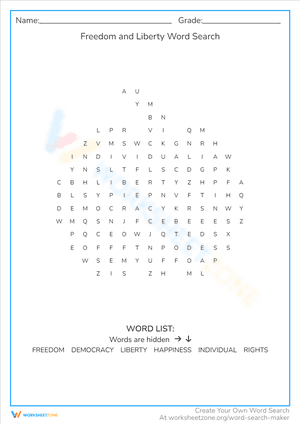
Last updated on August 30th, 2023 at 07:23 pm

NEW YEARS SALE! Become a Mrs. Merry member! Receive all mrsmerry.com printables for a one time fee of $35!

See more and Subscribe now .

Become a Mrs. Merry member! Receive all mrsmerry.com printables for a one time flat fee of $35!
Printable Feelings Chart for Kids | Emotion Skills
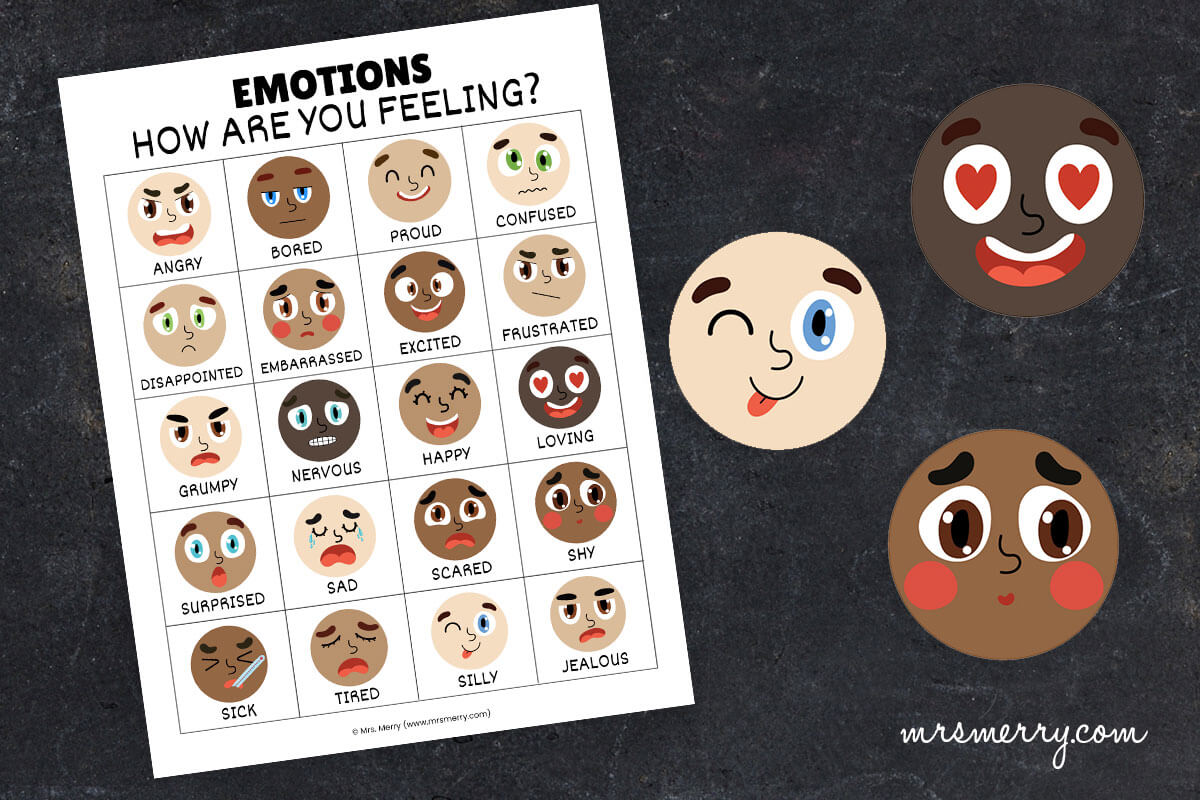
C hildren are full of so many feelings and one of the hardest things for them to do is learn how to navigate those feelings. What do they mean? How should I respond to them? Is it normal to respond this way or that way? Our Feelings Chart for Kids is a great guide to help kids recognize what they might be feeling at any given time on any given day.
A great emotions activity is to ask your children each morning to pick an emotion on the Feelings Chart that best matches how they’re feeling. Are they feeling sad, happy, loving, frustrated? There are so many emotions one can feel and sometimes just saying how you feel can help process those feelings on a different level.
Children sometimes don’t know why they are feeling a certain way and if it’s normal or right to feel one way vs. another. Having the chart displayed so your children or students can see the list of normal emotions is a great way to say “it’s ok to feel this way.” From there, talk about the feelings and how to respond to each emotion.
All about the Feelings Chart for Kids:
Our Feelings Chart for Kids consists of many emotions, 20 in fact. In addition to 20 of the most common emotions, they are shown with various skin tones.
Did they wake up feeling angry or shy today? Frustrated or sad? Pinpointing how they feel can help them overcome these uneasy feelings by learning to respond to them in a positive way.
Laminate the Feelings Chart
In my opinion, the emotions chart really should be laminated . It’s an inexpensive way to make a single piece of paper into something that can last forever. Laminate this and hang it on the fridge as part of a daily task you and your family can partake in.
Laminate the emotions sheet and each morning, have them circle (with a dry erase marker ), how they’re feeling. (Or they can use a magnet.) Not only will it make them feel better but it’ll also make everyone in your home feel better as well. As a parent, I believe firmly that knowing what my children are feeling (as well as what I am feeling) is truly half the battle.
We need to remember that people aren’t mind readers, and waking up to start your day knowing how/what your child is feeling will help you gauge how to best approach and react/respond to your child.
Educators, laminate this for each student and encourage them to use it throughout the day as an emotional/feelings check-in. Sometimes it’s easier for kids to “show” how they are feeling instead of “telling” it to the whole class.
Take a peek at what this free Feelings Chart for Kids looks like:
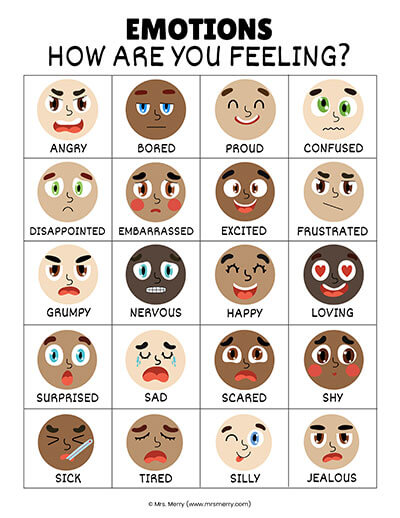
Scroll to the bottom of the page to get your free Feelings Chart.
Match the Feelings to the Picture
We have another great emotions activity for kids that can help you and your children or students learn about emotions and how they may appear.

In this feelings worksheet, we have listed 8 different pictures of various children displaying all different kinds of emotions from sad to silly, and surprised to angry — this worksheet shows a great visual of each emotion.
Match the emotion word to the correct face
It’s as simple as that! Have your children or students take 5 minutes to look at each picture on this emotions page.
Some questions to ask your children to help prep them for the feelings worksheet are:
- How do the children’s eyes look?
- Do they seem to be showing a good feeling emotion or a bad feeling emotion?
- How are their mouths portrayed?
- Are their eyebrows displaying any type of feeling to you?
After taking in all of the pictures, try to match the words on the bottom of the page to the pictures displaying the emotions.
The children can either cut the emotion words out and paste them under the correct emotion picture, or they can simply write the word under each picture.
Get your matching Feelings worksheet for kids at Mrs. Merry’s shop:
Get the Feelings Worksheet
How Do You Feel Worksheet for Kids
Another way to learn about emotions and the various ways people can visually portray them is with our How Do You Feel Worksheet.
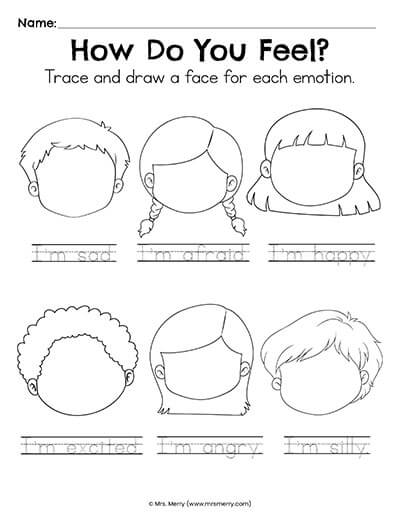
This worksheet consists of 6 different faces. The faces are blank, but underneath each face is a written emotion: “I’m sad”, “I’m afraid”, “I’m happy”, etc.” .
This emotions worksheet consists of two parts:
- In each blank face, draw what you think the below emotion looks like. Is the emotion statement, “I’m excited”? What does an excited expression look like to you ? Draw it and share it to get feedback on what an emotion may or may not look like.
- After finishing drawing what you think the emotion looks like, trace the emotion statement. Tracing this statement is a great way to remind the children that “this is what sad can look like”. Remember a child’s vision of what sad looks like can range from one child to the next. One child may draw a “sad face” in hysterics and tears and another student can draw a simple frown face. Neither is right or wrong, both show how that child perceives an emotion.
Get your How Do you Feel worksheet for kids at Mrs. Merry’s shop:
How Do You Feel Worksheet
Recognize your emotions with our Feelings Thermometer
I’m a firm believer that writing how you feel really helps express and narrow down how you’re feeling. Not only does writing it out help, but categorizing it by choosing where you fall on a feelings scale can really help.
Our Feelings Thermometer worksheet is a great way to teach children that it’s okay to feel a certain way and sometimes talking about those feelings and situations can help future emotions from being expressed in a way that might not be preferred.
Sometimes just knowing and recognizing how you’re feeling can calm someone down.
How does our Feelings Thermometer work?
Our Feelings Thermometer worksheet consists of 5 different colors. Bright green, dull green, yellow, orange and red.
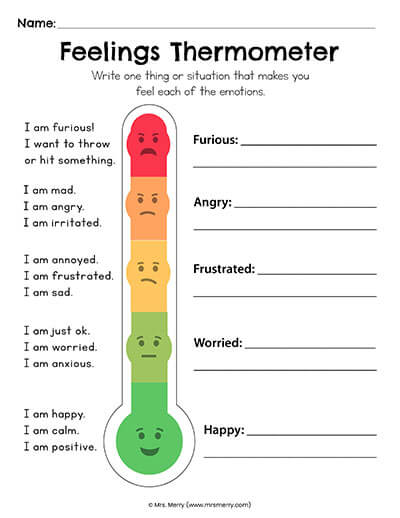
Each color represents an emotional category:
- Green = Happy
- Dull green = Worried
- Yellow = Frustrated
- Orange = Angry
- Red = Furious
There are different levels of emotion and, for example, angry can feel completely different than furious would feel.
Have your children fill out the worksheet. Have them write one thing or situation that makes them feel each of the 5 emotions listed.
To help your children or students, read the emotion statements on the left side of the worksheet to help them identify how they are feeling, or help them recall a time in the past when they experienced those emotions.
Was your child upset when their sibling took a toy from them? Did it make them mad and irritated? Or did it make them so mad that they wanted to throw something? Help them identify the different ranges of emotions with our Feelings Thermometer worksheet.
Get your Feelings Thermometer worksheet at Mrs. Merry’s shop
Feelings Thermometer Worksheet
Need an emotional activity that is less structured? Try our Feelings Word Search
I love word searches. My kids love word searches. They are great kids activities that can say a lot by doing a little. Our Feelings Word Search is a great way to conclude a feelings or emotions lesson for the day.
Did you spend the day talking about emotions and how to respond to each? Our Feelings Word Search is a great way to end that emotions lesson plan with a light activity.
Simply find the 10 different emotion words in our Emotions Word Search. The emotion words are only up and down (diagonal words are not listed).
Have each child find the emotion words in the word search and then take a minute to discuss each emotion and what was learned that day about each.
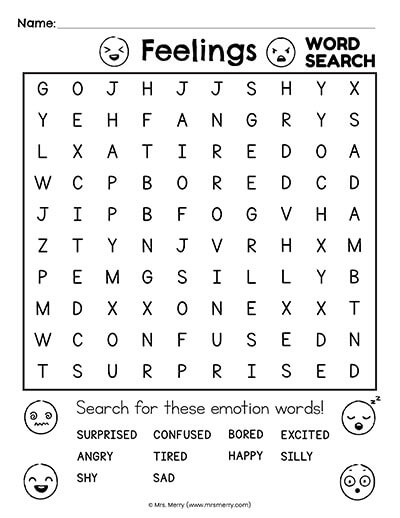
The Feelings Word Search includes the Answer Key for quick discovery of each emotions word.
Get your Feelings Word Search at Mrs. Merry’s Shop
Feelings Word Search
Cool down with our Calming Coloring Pages
I could not complete my Emotional Learning Bundle Package without including some Calming Coloring Pages.
Sometimes we just need to sit in the corner and color! Coloring is healing and a wonderful calming activity for everyone, including adults! That’s why there are endless options of Adult Coloring Books available out there. A great adult coloring book is the Animal Adult Coloring Set . A great pick if you’re an animal lover!
Our Calming Coloring Pages come in 4 different options:
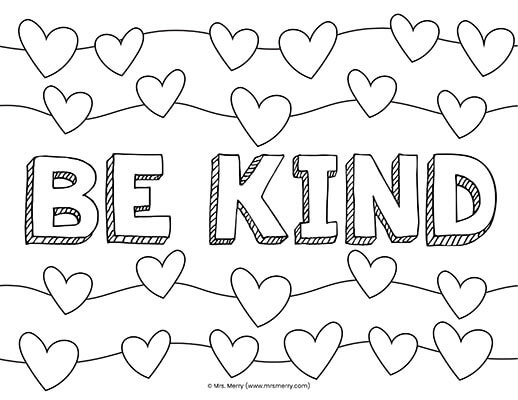
This is the biggest message I want to push right now. Really if you’re going to be anything at all, just be kind. You can’t go wrong with treating people the way you want to be treated.
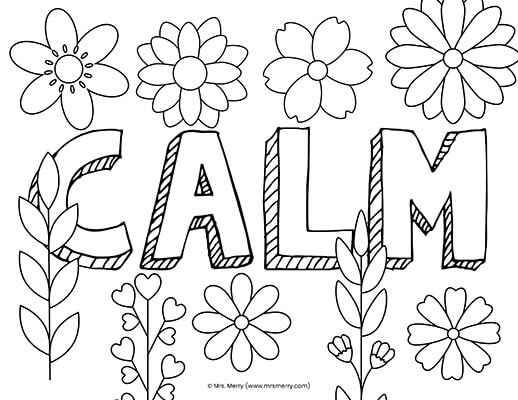
Stop and smell the roses! Life can be busy and sometimes it’s hard to just be calm. The pressure is real, especially these days, so it’s important to take a few minutes out of your day and just say “I am calm.”
3. Take a Deep Breath
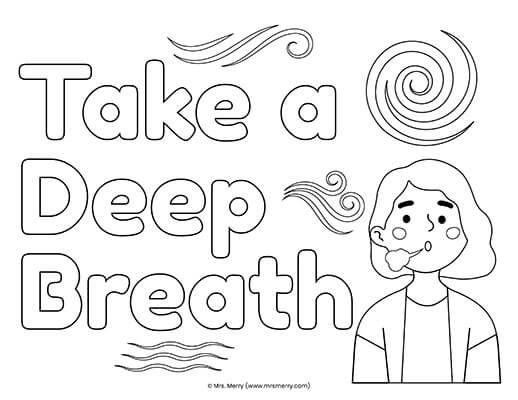
Breath in through your nose and out through your mouth! The best way to really relax yourself is by taking a few deep breaths. This will help relax your mind and body.
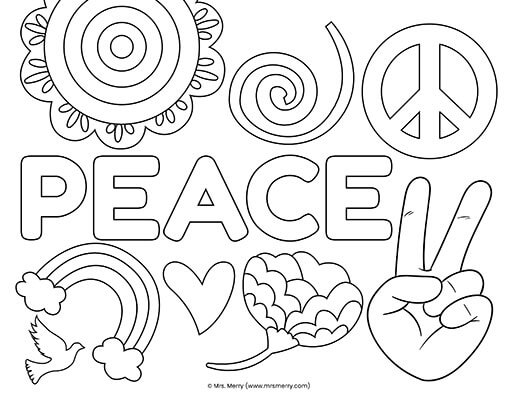
Lastly, peace. Why not, right? We all want peace and love in the world. So let’s focus on the good and help change the bad. Color this peaceful coloring page to help bring some zen into your life.
Our 4 Calming Coloring Pages is a great activity for kids to color at home or in the classroom, or perhaps even taking them into a calming corner. Grab your crayons , markers or colored pencils and bring yourself back down.
Get your 4 Calming Coloring Pages at Mrs. Merry’s shop:
4 Calming Coloring Pages
Keep Calm with our How to Keep Calm Sign
For our last emotions printable, our How to Keep Calm Sign is a great resource to hang at home or in the classroom.
We’ve talked about emotions, feelings and how to see or speak to them. But what do you do about them? What do your children do when they’re feeling angry, sad, or frustrated?
Our How to Keep Calm Sign lists 10 different ways to help you stay calm, cool and collected.
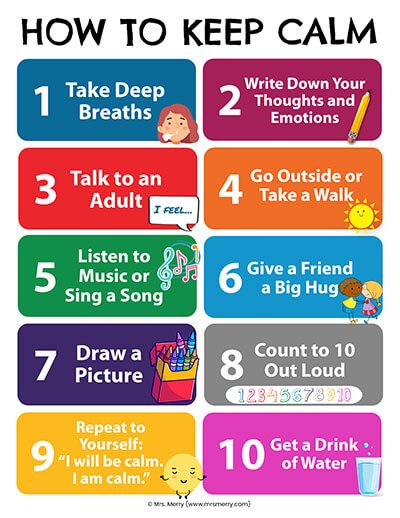
Hang this in your classroom to remind your students of a few ways they can help themselves handle an emotion or feeling! Can they think of anything more?
Laminate this sign to make it long-lasting. I have found that some students like to touch signs, especially when the sign is related to feelings or behavior. Laminating the sign can help keep the sign intact and last longer. It also makes it easy to wipe down and keep clean!
Use a dry erase marker and have your children or students circle the calming activity that helped them calm down.
There are many different ways to use our How to Keep Calm poster. Guide your student on how to recognize and conquer their feelings!
Get your How to Keep Calm sign at Mrs. Merry’s shop
How to Keep Calm Sign
Do you like all of our Emotional Learning Printables?
Are you planning an emotional learning or feelings lesson? Recognizing emotions and how to respond to them can be one of the most important learnings during childhood. Spend some time with your children learning the various emotions they can feel, and ways they can handle and express each emotion.
You can get all of our Emotional Learning Printables at Mrs. Merry’s shop as part of an all-inclusive bundle. Save and buy the bundle for $10.
Get all 10 Emotion Printables for just $10
Get the Emotional Learning Bundle Now
Whether you choose to buy our Emotional Learning printables or not you still get our Feelings Chart for FREE.
Get your Feelings Chart for Kids:
Need some craft supplies.
Amazon has always been my go-to for most of my office and craft supplies. If you print a lot of printables and spend time coloring, gluing and adding some extra jazz to them, our list of supplies can help!
I’ve split the list up into a basic list and a fancier list if you’re going to put a little more pizazz into your printables.
The basic list:
- White paper
- White cardstock
- Scissors (for adults)
- Scissors (for kids)
- Liquid Glue
- Colored pencils
- Fine-point Dry Erase Markers
- Scotch tape
- Double-sided tape
- Laminate Self-sealing Pouches (no machine needed)
- Velcro dots
- Hole Puncher
- Craft String
- Ornament Hooks
The fancier list:
- Pipe cleaners
- Glitter glue
- Googly eyes
- Construction paper
Other Mrs. Merry School Printables:
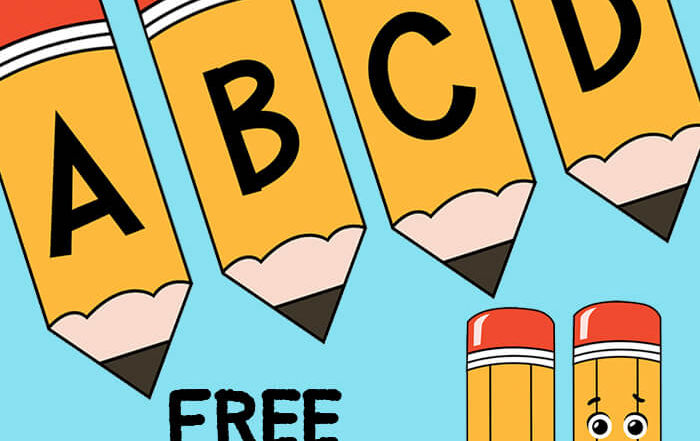
Pencil Template & Letter Banner Printable

Free Printable Goal Setting Worksheets for Kids
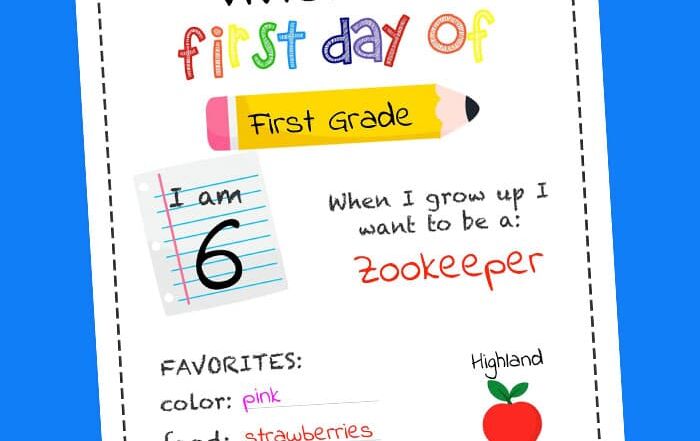
Editable First Day of School Sign Printable
Download the feelings chart.
Help your students easily describe what they're feeling with this free Feelings Chart. Pin it on a bulletin board or the wall and have your student or child mark how they're feeling that day. Grab it now!
Printables from mrsmerry.com are copyright protected and for personal use and classroom use only . Mrs. Merry printables are not for commercial use. Thanks and have a very merry day!
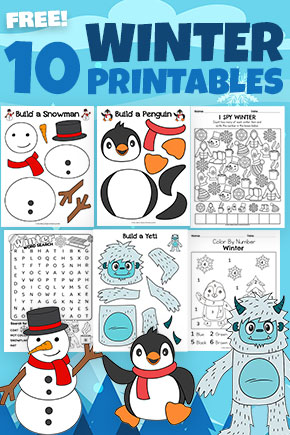
This Months Most Popular Posts
Item of the week.

Have you heard of this idea?
Have your kiddos' teacher/teachers write a personalized message in this book at the end of each school year. Give it to your kid(s) when they graduate high school.
Leave A Comment Cancel reply
Privacy overview.
Over 6,200 homeschool resources and growing!

Free Feelings and Emotions Printables and Activities
Published: March 24, 2015

Contributor: Sarah Shelton
Disclosure: This post may contain affiliate links, meaning if you decide to make a purchase via my links, I may earn a commission at no additional cost to you. See my disclosure for more info.
Do your little ones need help understanding feelings and emotions? When my daughter was very young it was clear that she had sensory issues and self control was definitely an issue. We often said “use your words” to try and get her to communicate how she was feeling, but sometimes she couldn’t. Using printables and activities on feelings and emotions helped her to express her feelings more accurately.
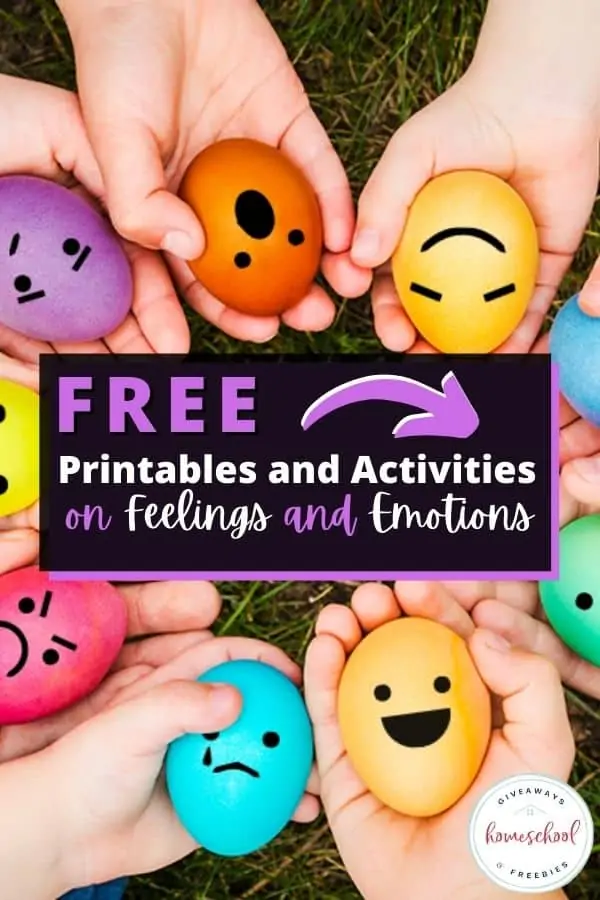
Helping Children Express Feelings and Emotions
If your child has difficulty expressing emotions, you may be wondering how to get them to talk about feelings. Teaching your child how to to identify and express emotions can be difficult, especially if you are not a very sensitive person. Free emotions downloads might prove to be super helpful for you. You can use a feelings chart for kids or an emotions worksheet to help teach them how to express themselves.
When I was a child I grew up in an abusive and severely dysfunctional home. This has caused me to handle my feelings quite a bit differently than many people. I learned how to put up walls and hide how I felt. Tragically, this caused me heartache when my youngest daughter was struggling with her feelings and didn’t know how to express them.
Ways to Express Feelings
We tried many different ways to get our daughter to express how she was feeling, we used feelings pictures, an emotion chart for kids, a fun feelings activity, but what I found most helpful when she couldn’t express herself adequately were using emotion flashcards. We have included some free emotions flashcards in our Feelings and Emotions Activity Pack below.
Ideas for Expressing Emotions
- You can use a teaching feeling game, printable emotion cards, or a feelings game printable to help your young ones understand how and why they are feeling a certain way.
- Use emotion cards pdf files to print and use to help identify feelings.
- A feelings worksheet can be super helpful to use to work though feelings as you ask your child questions and work through visuals.
- Feeling faces printables (like the freebie we have below) can help non-verbal children explain how they feel.
- Use feelings flashcards that show emotions (great for visual learners).
- Print and use our emotions chart with faces that can help keep track of bad days. A feeling chart for kids can help you reflect on what may have contributed to certain emotions.
- You can have lots of fun playing and reading books while learning about how to handle your feelings and emotions.
Learning how to help children work through feelings and emotions can radically change your home.
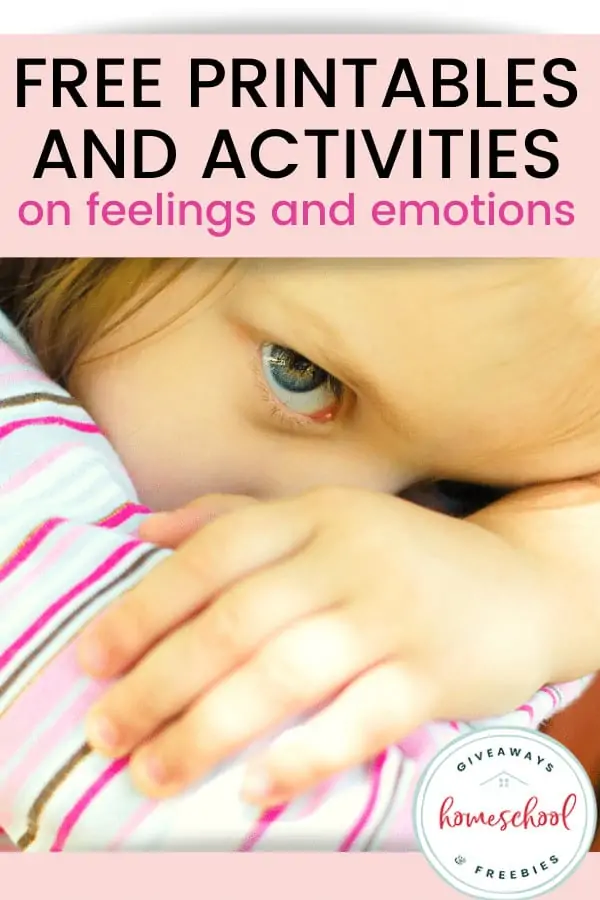
How do you use flashcards for feelings?
Using flashcards for feelings and emotions can help toddlers or even older children tell us how they are feeling. Even a non-verbal child can often look at an angry face and tell it’s angry. If we lay out several flashcards with emotional faces on them, we can help them point to how they are feeling.
Feeling Flashcards
Feelings and Emotions flashcards can also be used as a game. You can get creative and make up stories that reflect the emotions and feelings of the face on the flashcard.
Feelings Journal Printables:
Keeping track of your child’s feelings and emotions using a feelings journal can be helpful when you are trying to determine sensory triggers, or other emotional responses that are out of the ordinary.
Emotions Journal
Logging everything in the emotions journal will help you spot patterns. Even things such as the weather, sleep the night prior, meals, and activities. Journaling about feelings can help you become aware of situations that you might need to consider avoiding.
Social Emotional Learning Skills
Social Emotional Learning Journal – These journal prompts focus on self-awareness and help you teach social emotional learning skills.
Coping Strategies Notebook – This free emotions template can help you create a feelings and emotions binder that you can use to log situations and detail how certain coping strategies hurt or helped.
Printable Gratitude Journal Templates – It’s a great idea to also keep a list/log of all the things your child is grateful for so you can reference it when troubles arise.
Expressing Big Feelings
Whether you have younger children or older kids , they are likely to have big feelings (most of us do!). It can be difficult for children to express different emotions, and that’s where printable feelings charts can be a powerful tool.
Learn and Teach Emotion Words
If you have a child who is prone to throwing a temper tantrum, they may need help understanding their own emotions. You can keep an emotional vocabulary handy, and teach them emotion words to use to express their own feelings.
Printable Facial Expressions
You can also use a feelings book or journal that has feelings faces if you have a non-verbal child. The best way to help them express their various emotions is to allow them to show you the face that best explains how they are feeling.
Games that Teaching Feelings and Emotions:
You can use a free printable feelings board game to help your child practice mastering his feelings. There are also some great board games that you can invest in that your whole family can play.
Feelings Game Printable
Games are a fun and non-threatening way to get children to communicate how they are feeling without a lot of pressure. Children who are struggling to express themselves might be able to act out a situation that reflects how they are feeling.
Discover some new coping strategies to handle difficult emotions.
- My Feelings Game – Explore more than 200 scenarios that will help your child talk about his feelings. Discover strategies to help children cope with emotions in a socially acceptable way.
- Positive Traits Game – This coping skills game is perfect for group or solo play. It includes trait pictures and discussion cards with 10 different ways to play.
- Emotional Rollercoaster – This emotions board game looks like a fun way to help work through difficult emotions, such as anger management.
Using Printables to Help Kids Share Feelings
When my daughter struggled with sensory processing, I never thought to browse google for an emotions worksheet that would help her express the way she was feeling. Learning how to help kids with emotions can be difficult. We created our own pages using hand-drawn emoji faces before we finally just created an emotions worksheet, which grew into a whole activity pack, complete with feelings pictures instead of hand-drawn ones. She enjoyed this much more.

Resources for Kids to Express Their Feelings
There are so many free resources on emotions that can be helpful for young children who struggle to express their feelings and communicate what they are feeling.
Free Emotions Downloads
We have created several free printables on feelings and emotions along with activities that can help your kids communicate their feelings, and teach your child to identify and express emotions and learn how to cope when they feel overwhelmed. These free feelings printables can be of great help to you.
Overwhelming Emotions
Sometimes emotions can be really overwhelming for little ones to understand, and sometimes you can have kids that are overly emotional and need help getting themselves in check. That’s where using fun printables and games come in handy. Printable emotion cards for adults can even come in handy when you are dealing with special needs.
Free Feelings and Emotions Printables:
We have done the legwork of searching for printable emotions worksheets, face emotion cards, a feelings chart for kids, and feelings games that you can use to teach coping skills. Be sure to grab our free resources as well; you’ll find them below.
Feelings and Emotions Flash Cards:
Emotion Word Cards – These emotion picture word cards are great for non-verbal children who know how to read.
Printable Managing Emotions
Printable Emotion Flashcards – I like the LEGO mini figure faces options for these emotions flashcards. Using free printable emotion faces is great, especially for non-verbal children.
Emotions Printable Cards
Montessori Emotion Monster Cards – These free printable emotions cards are cute. Your kids struggling with anger, jealousy, or frustration? These cards can help them tell you how they feel.
Feelings and Emotions Task Cards:
Task cards can be helpful as a springboard for conversation. When kids struggle to communicate what they are feeling, they may act out and behave in ways that you don’t allow, such as yelling, stomping feet, talking back, or maybe even hiding in a corner.
Consider using some emotions task cards as scenarios to get your kids to open up about how they feel.
Social Problem-Solving Task Cards – I love these conversational task cards that can help you work with your child on what to say and how to act with different situations.
Growth Mindset Task Cards – This free task cards pack is targeted for special needs children in grades 4-7. The scenario questions can help your child process different responses.
Social Problem Solving Task Cards – Grab this pack of free task cards that include social scenarios and situations that children can talk about and identify how they would solve each situation.
Emotions Clip Cards:
Using clip cards is a great way for non-verbal children to show you how they feel.
Printable Clip Cards for Learning Weather and Emotions – These emotions clip cards are cure and the weather theme would be fun to use when you are doing science lessons focused on teaching your children about weather .
Animal Emotions Clip Cards – Themed clip cards using the faces of animals. Perfect for your animal-loving child!
Feelings and Emotions Posters and Charts:
Using posters and charts is a good way to track progress of handling tough situations. Children can often be encouraged when they see how far they’ve come.
Don’t Give Up! An Object Lesson for Kids Who Feel Down – Change your child’s attitude from defeated to encouraged with this activity that changes experiences from negative to positive.
The Power of Yet Posters – Use these encouraging posters to help your struggling child realize that practice makes things easier.
Feelings Chart for Kids
Character Emotions Chart – If you like tracking progress, then this emotions chart of faces is a great visual tracker. You could laminate it and stick it in your homeschool binder .

Unit Studies on Feelings and Emotions:
Older students may enjoy using unit studies instead of cute printable feelings worksheets that may feel too childish for them. Check out these unit studies to help kids express emotions.
Learning About Emotions and Feelings – This free unit study on facial expressions can help your child identify facial expressions. You can even have fun and practice mimicking the facial expressions.
Inside Out Study Guide for Teens: Understanding Emotions – This fun study guide for “Inside Out” (Disney/Pixar) is a great handy guide for teens.
Don’t Be An Angry Bird free printables for an anger management/feelings unit study from The Home Teacher . The goal of this book is to help your child understand their anger and learn some appropriate strategies to deal with it.
More Free Printables on Feelings:
Exploring Emotions with Lego Faces from Homeschool Encouragement – these are for ages K-2 and are great to use with Lego mini figures with different facial expressions as part of a unit study on feelings.
Conversation Skills Lessons – Free social skills lessons for older students that will help them develop better conversational skills.
Self Expression Through Writing & Art- Free Self Esteem Worksheets – Children can often draw pictures of what they are feeling and this fun self expression printable helps them thing through their feelings and get it all put on paper.
Great articles on helping children understand their emotions:
- Bible Verses for Guiding Kids Through Life Situations
- Bible Verses to Help With Children’s Insecurities
- Targeting Social Skills in Your Homeschool
Download Emotions Printables
You can login to our subscriber library to download our free feelings and emotions printables. Not yet a subscriber? No problem! Sign up below to get access.
Thanks for signing up to access our free printable emotion faces PDF. Access more than 50 freebies in the subscriber library with the password: HSGSL922
The dowload links for each of the emotions printables, including some emotion faces are below.
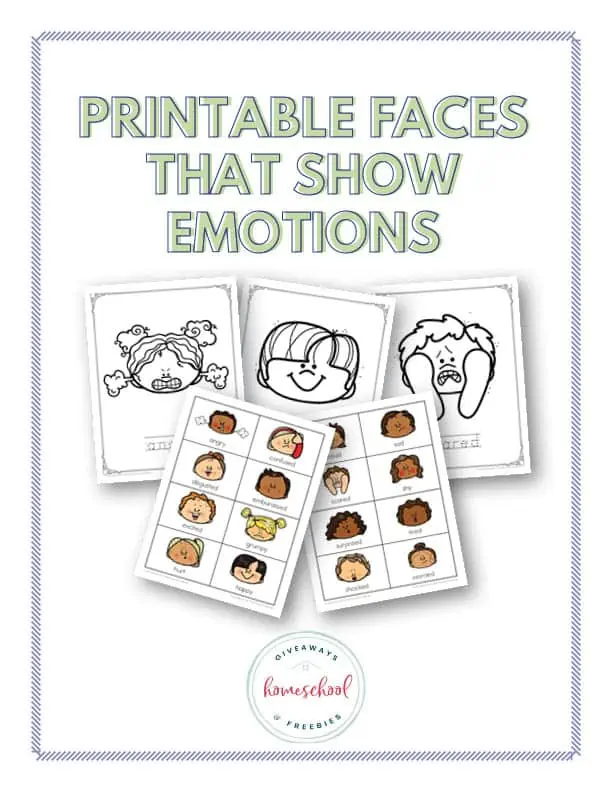
- Emotion Faces Printable for Kids PDF
- My Feelings & Emotions Tracker
- Feelings and Emotions Activity Pack
- Free Scripture Memory Cards on Emotions
Sarah Shelton
Sarah is a wife, daughter of the King and Mama to 4 children (two homeschool graduates) She is a an eclectic, Charlotte Mason style homeschooler that has been homeschooling for over 20 years.. She is still trying to find the balance between work and keeping a home and gardens. She can only do it by the Grace of God, coffee and green juice
Related resources

58 Bible Verses on Gratitude with Free Activities
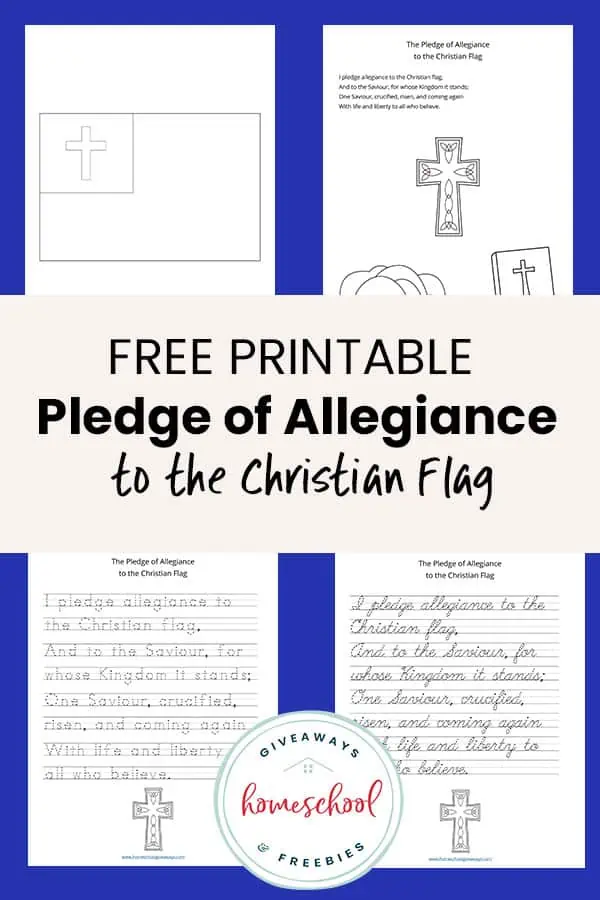
Free Printable Pledge of Allegiance to the Christian Flag
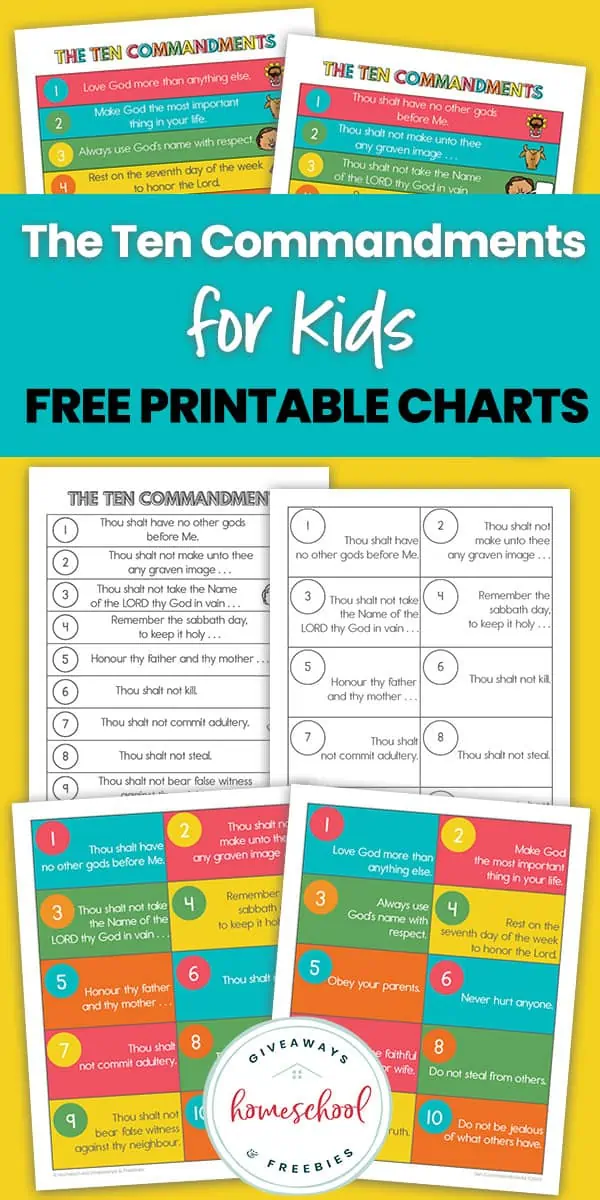
The Ten Commandments for Kids Free Printable Chart
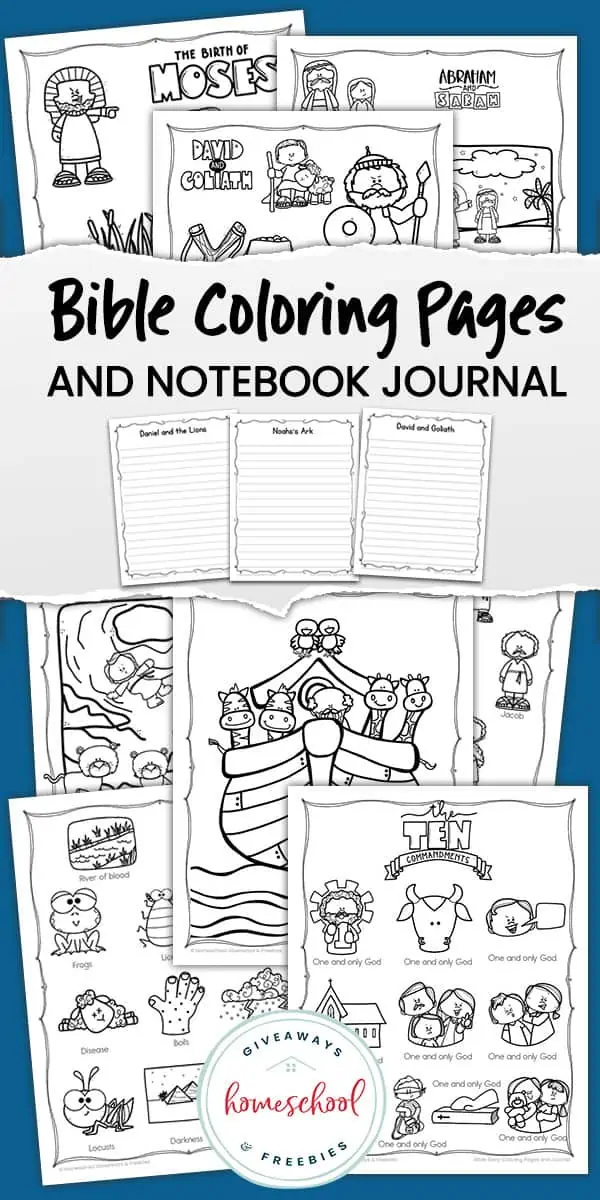
Free Bible Coloring Pages from the Old and New Testaments

How to Study Hymns (Free Hymns Copywork Pack)

Giving Kids Faith and Hope


Reading & Math for K-5
- Kindergarten
- Learning numbers
- Comparing numbers
- Place Value
- Roman numerals
- Subtraction
- Multiplication
- Order of operations
- Drills & practice
- Measurement
- Factoring & prime factors
- Proportions
- Shape & geometry
- Data & graphing
- Word problems
- Children's stories
- Leveled Stories
- Context clues
- Cause & effect
- Compare & contrast
- Fact vs. fiction
- Fact vs. opinion
- Main idea & details
- Story elements
- Conclusions & inferences
- Sounds & phonics
- Words & vocabulary
- Reading comprehension
- Early writing
- Numbers & counting
- Simple math
- Social skills
- Other activities
- Dolch sight words
- Fry sight words
- Multiple meaning words
- Prefixes & suffixes
- Vocabulary cards
- Other parts of speech
- Punctuation
- Capitalization
- Narrative writing
- Opinion writing
- Informative writing
- Cursive alphabet
- Cursive letters
- Cursive letter joins
- Cursive words
- Cursive sentences
- Cursive passages
- Grammar & Writing
Breadcrumbs
- Social & emotional
Feelings & emotions
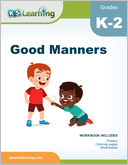
Download & Print Only $2.99
Reading faces
Facial expressions are the clearest indication of someone's feelings. In these SEL exercises, students relate faces to emotions .

These worksheets are available to members only.
Join K5 to save time, skip ads and access more content. Learn More
What is K5?
K5 Learning offers free worksheets , flashcards and inexpensive workbooks for kids in kindergarten to grade 5. Become a member to access additional content and skip ads.
Our members helped us give away millions of worksheets last year.
We provide free educational materials to parents and teachers in over 100 countries. If you can, please consider purchasing a membership ($24/year) to support our efforts.
Members skip ads and access exclusive features.
Learn about member benefits
This content is available to members only.
- Forgot Password?
The Emotion Wheel: What It Is and How to Use It [+PDF]

A study by The Greater Good Science Center suggests there are 27 distinct emotions – at least (Cowen & Keltner, 2017). And that does not even include combinations of emotions.
With so many emotions, how can one navigate the turbulent waters of feelings, without getting lost?
The answer: with an emotion wheel.
Through years of studying emotions, American psychologist Dr. Robert Plutchik proposed that there are eight primary emotions that serve as the foundation for all others: joy, sadness, acceptance, disgust, fear, anger, surprise, and anticipation. (Pollack, 2016)
So while it’s hard to understand all 34,000 distinct emotions, we can learn how to identify the primary emotions and act accordingly. It’s especially useful for moments of intense feeling and when the mind cannot remain objective as it operates from an impulsive “fight or flight” response. (Watkins, 2014)
Before you read on, we thought you might like to download our three Emotional Intelligence Exercises for free . These science-based exercises will not only enhance your ability to understand and work with your emotions but will also give you the tools to foster the emotional intelligence of your clients, students or employees.
This Article Contains:
- What is Plutchik’s Wheel of Emotions?
- How to Use Plutchik’s Wheel of Emotions
2 Emotion Wheel Worksheets
- What is the Difference Between Plutchik’s Wheel of Emotions and the Geneva Emotion Wheel?
How to Use an Emotion Wheel in Counseling with Quenza
Controlling emotions through vertical development.
- A Fun Test Using Plutchik’s Wheel of Emotions: Who Are You Really According to the Emotion Wheel?
A Take-Home Message
What is plutchik’s wheel of emotions.
Let’s take a look at each of these emotions. But first, how about a clear idea of what we mean when we use the term “emotion.”
In previous studies, researchers of emotions saw them as episodes influenced by stimuli. More specifically,
“emotion is defined as an episode of interrelated, synchronized changes in the state of all or most of the five organismic subsystems in response to the evaluation of an external or internal stimulus event as relevant to major concerns of the organism” (Emotion Researcher, 2015).
Below is a table from the International Handbook of Emotions in Education. It shows the relationship between these various factors and sub-systems, as well as their presumed functions (Pekrun & Linnenbrink-Garica, 2014). There are also plenty of books on emotional intelligence .
Emotions influence our actions in five main ways.
1. Emotion Component
This is where an individual simply experiences the feelings. It’s about monitoring the internal universe and recognizing what is being experienced at that time.
2. Action Tendency Component
Once the emotion is identified, the body moves into action. Emotions bestow certain actions instead of others, which means that while some are beyond our control (and thankfully so), like pulling your hand away from a hot iron, others are within our control, facing the fear to continue with a speech or a presentation.
3. Appraisal Component
By cognitively analyzing the emotion, the individual is able to pick up on the situations, actions, environments, or individuals that are causing the emotion. This aids the individual in tracking how these stimuli impact their wellbeing. It’s also invaluable for helping communicate the state of our internal world with others.
4. Motor Component
This is the communicative function of how we express what we are experiencing (facial expressions, hand gestures, body movements, etc.). So it is extremely important on the inter-individual level, as well as that of the individual.
5. Physiological Component
This component supports all others and is the chemical reaction that our body experiences. For instance, the rush of blood flow to the hands occurs when one experiences the emotion of anger.
While the components of the emotions we feel are present in all individuals, the intensity and expression of these emotions differ from one person to another. There are also social factors like gender, culture, and race, that influence why people may feel emotions differently despite similar situations.
For example, hearing words like: “I am afraid,” “I feel jittery,” “I don’t want to be here,” or “I just don’t have enough time to prepare for the final,” are all part of the different components of an emotion.
“The first expression (I am afraid) describes a subjective feeling of fear. The second example (I feel jittery) refers to the physiological component of an emotion. The third example (I don’t want to be here) indicates an avoidance action tendency, which may or may not be carried out. The fourth example describes several appraisals of the situation, including goal frustration (I am not prepared) and lack of power (I do not have enough time). Observable motor activities are also associated with emotions. For example, facial expression, such as smiling or frowning, body postures, such as opening the arms or raising the fists, and changes in the voice, such as raised pitch, can be observed in emotional situations.”
(Pekrun & Linnenbrink-Garica, 2014)
The Wheel of Emotions
Now that the complex system of emotions, and all its components, is a bit more clear, we can dive into the work of Plutchik and his wheel. (Pico, 2016)
The eight primary emotions that he identified, which are the basis for all others, are grouped into polar opposites:
- joy and sadness
- acceptance and disgust
- fear and anger
- surprise and anticipation
The foundation of his emotions theory stems from the following ten postulates: (Changing Minds, 2016)
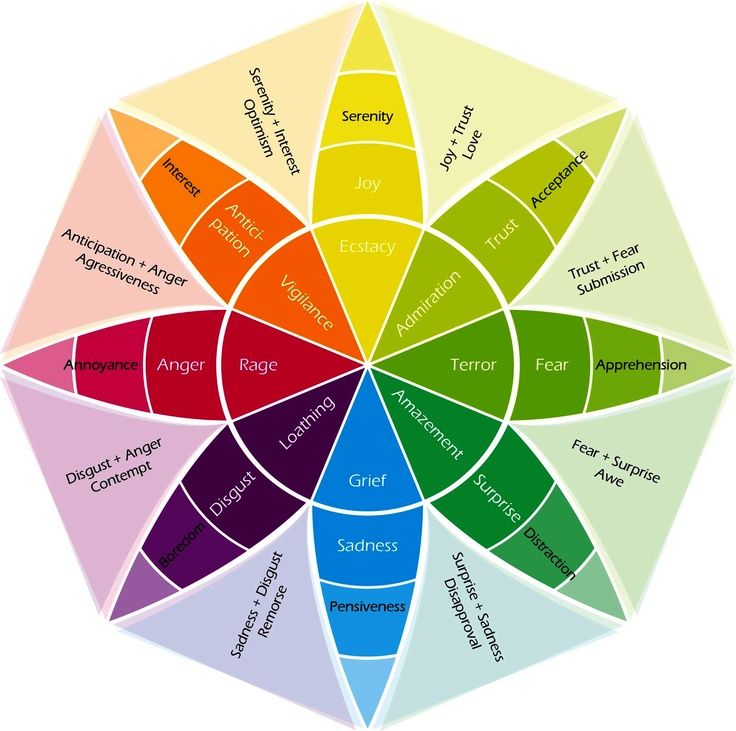
- Animals and Humans The midbrain (or the limbic system) of a human is similar to that of other mammals. Animals and humans experience the same basic emotions.
- Evolutionary History Emotions came into being as part of the evolutionary process, long before there were apes or humans.
- Survival Issues The most influential role of emotions is to help us survive.
- Prototype Patterns These are the common identifiable patterns and elements that make up each emotion.
- Basic Emotions The most basic emotions are the primary ones: trust, fear, surprise, sadness, disgust, anger, anticipation and joy.
- Combinations The adding up of these various primary emotions will produce new ones such as: love = (joy+ trust), guilt = (joy + fear), and delight = (joy + surprise).
- Hypothetical Constructs Emotions are constructs, or ideas, that help describe a certain experience.
- Opposites Like many things in nature, there is a duality with emotions, hence each one has its polar opposite: – saddens is the opposite of joy – trust is the opposite of disgust – fear is the opposite of anger – surprise is the opposite of anticipation
- Similarity The degree of similarity determines which emotions are more related, and which ones are the complete opposite.
- Intensity This degree of change in intensity, from very strong to not so much, produces the diverse amount of emotions we can feel. Such as: – trust goes from acceptance to admiration – fear goes from timidity to terror – surprise goes from uncertainty to amazement – sadness goes from gloominess to grief – disgust goes from dislike to loathing – anger goes from annoyance to fury – anticipation goes from interest to vigilance – joy goes from serenity to ecstasy
Elements of the Wheel
Looking at the wheel we can notice three main characteristics:
The eight emotions are arranged by colors that establish a set of similar emotions. Primary emotions are located in the second circle. Emotions with softer colors are a mix of the two primary emotions.
Moving to the center of the circle intensifies the emotion, so the colors intensify as well. For instance, at the center of the wheel, the primary emotions change from: anger to rage; anticipation to vigilance; joy to ecstasy; trust to admiration; fear to terror; surprise to amazement; sadness to grief; disgust to loathing. Moving to the outer layers, the colors become less saturated, and the intensity of the emotions lowers.
The polar opposite emotions are across from each other. The spaces between the emotions demonstrate combinations when primary emotions mix. So we see the emergence of emotions like love, submission, optimism, aggressiveness, contempt, remorse, disapproval, awe, and submission.
The ability to identify one’s emotions is a skill related to emotional intelligence (Salovey & Mayer, 1990).
Those high in this skill can communicate more detailed emotional experiences and use a greater emotional vocabulary. Research has found that helping individuals expand their emotional vocabulary can help them regulate their emotions more effectively (Kircanski et al., 2012).
The Feeling Wheel was designed by Gloria Willcox (1982) and is a great starting point for those who find it challenging to identify their emotions.
You can use the wheel for:
- Exploring the emotions you are feeling at any given moment of the day.
- Daily self-reflection where you identify the emotions you experienced throughout the day.
- Exploring deeper and longer-term emotions that may be affecting you.
- Helping your therapy or coaching clients describe their experiences in greater detail.
It must be noted that you can experience a diverse number of emotions simultaneously, and that the wheel should not be used for avoiding emotions or replacing ‘negative’ emotions with ‘positive’ ones. Instead, the goal is to identify your emotional experience, accept it as it is, and communicate it if you wish.

How to Use Plutchik’s Wheel of Emotions
The beauty of this tool is in its ability to simplify complex concepts. Understanding is a crucial step to solving any dilemma. When the question concerns our emotions that we process on a subconscious level, it can be hard to first identify and verbalize our needs.
This is why the tool is so useful. It enables the user to visualize their emotions, and understand which combinations of emotions created this outcome.
Once we objectify and understand the emotions, we can empathesize with ourselves, and channel our focus in the direction of emotions we actually want to feel.
There are two ways to use the wheel, either as a two-dimensional circle or a three-dimensional ellipse. Utilizing it as a two-dimensional circle lets the individual dive into the emotion wheel. This then helps them discover what primary emotions they are feeling, as well as how emotions combine to create secondary emotions like awe, remorse, aggression, optimism, etc.).
When utilizing it as a three-dimensional form, the individual can view the emotional intensity of the primary and secondary emotions. (Roeckelein, 2006)
According to Plutchik’s Sequential Model, emotions are activated due to specific stimuli, which set off certain behavioral patterns. (Krohn, 2007)
He identified the following survival behaviors that drive our actions:
Protection : Withdrawal, retreat (activated by fear and terror)
Destruction: Elimination of barrier to the satisfaction of needs (activated by anger and rage)
Incorporation: Ingesting nourishment (activated by acceptance)
Rejection: Riddance response to harmful material (activated by disgust)
Reproduction: Approach, contract, genetic exchanges (activated by joy and pleasure)
Reintegration: Reaction to loss of nutrient product (activated by sadness and grief)
Exploration: Investigating an environment (activated by curiosity and play)
Orientation: Reaction to contact with an unfamiliar object (activated by surprise) (Screenr, 2017)
This means that when our emotions are activated, they are done so to elicit one of the survival behaviors. Of course, all of this happens on a subconscious level.
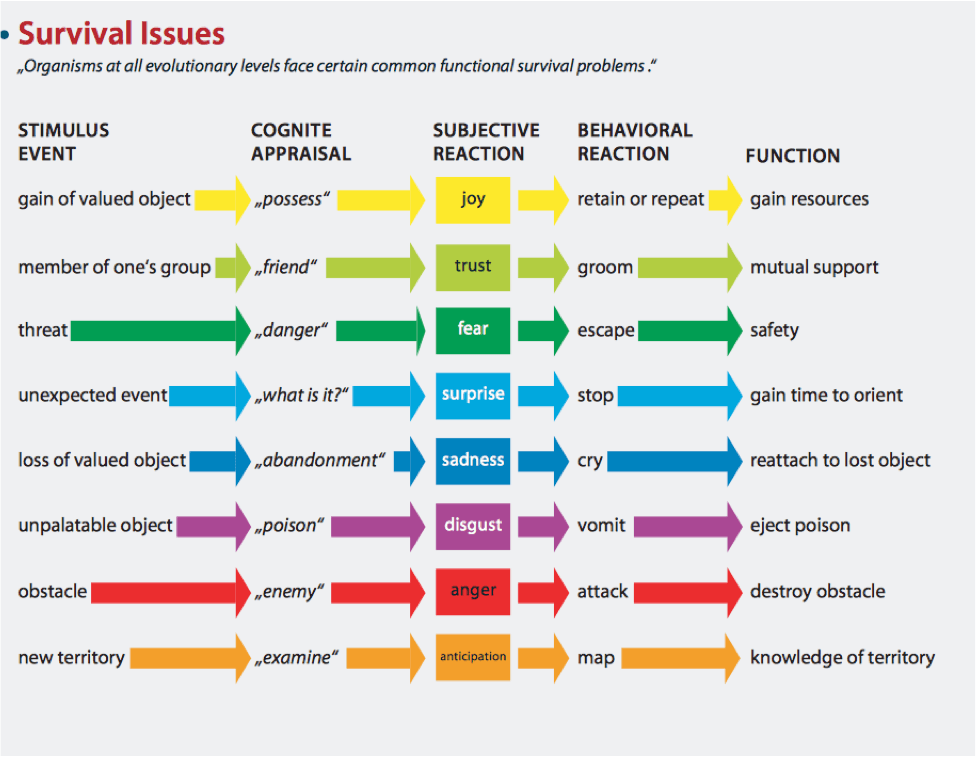
To tap deeper into the mind and get to the root cause of these internal emotions, here are several worksheets to assist through the process:
- Clear and brief: emotions Provides a snapshot view of emotions , and the way they are trigged in the mind. Outlines the developmental levels our emotions grow through. And what it means to be emotionally intelligent.
- Seeing Emotions Sometimes it helps to see a visual explanation of a word or concept. If you would benefit from common facial expressions associated with each emotion, then this worksheet is for you. Browse and identify feelings by matching their expressions.
- Extra: How to Improve Emotional Intelligence in the Workplace .

Download 3 Free Emotional Intelligence Exercises (PDF)
These detailed, science-based exercises will help you or your clients understand and use emotions advantageously.
Download 3 Free Emotional Intelligence Tools Pack (PDF)
By filling out your name and email address below.
What is the Difference Between Plutchik’s Wheel of Emotions and the Geneva Emotion Wheel?
Plutchik’s wheel is not the only tool available for understanding and interacting without emotions. There are other emotion wheels that help us understand and detect our emotions, such as the Geneva Emotion Wheel (GEW). (Affective Sciences, 2017)
While both wheels focus on emotions and their intensities, the GEW uses a different approach. To start with, there are no primary emotions, rather a set of 20 emotions that are evaluated by two sets of polar parameters (version 2.0 has 20 emotions, while the first model listed 16).
The two parameters are valence (describing a situation as unpleasant or enjoyable), and control/power (looking at whether or not the individual has high or low control over the situation, and it’s outcomes).
Another big difference between the two is the intensity of the emotions. The GEW has reversed its intensity, with the strongest emotions represented by larger circles on the outer layers; these decrease in size as they approach the center.
One of the biggest differences between these emotional intelligence tools is that the Geneva Emotion Wheel also gives individuals an ability to select options for ‘no emotions’ or ‘other emotions.’
That’s because it “gives respondents much freedom to express themselves. [It’s important to] note that a pure free response format can be disadvantageous because there may be a huge variation in how and how well respondents express themselves in their own words (e.g., Gohm & Clore, 2000), and the resulting variability in measurements across individuals and situations may reduce measurement reliability.” (Sacharin, Schlegel, & Scherer, 2012)
Another big difference is that Plutchik’s wheel does not express emotions such as pride and shame, which the GEW does. Aside from that, both tools provide a great starting point for detecting one’s emotions.
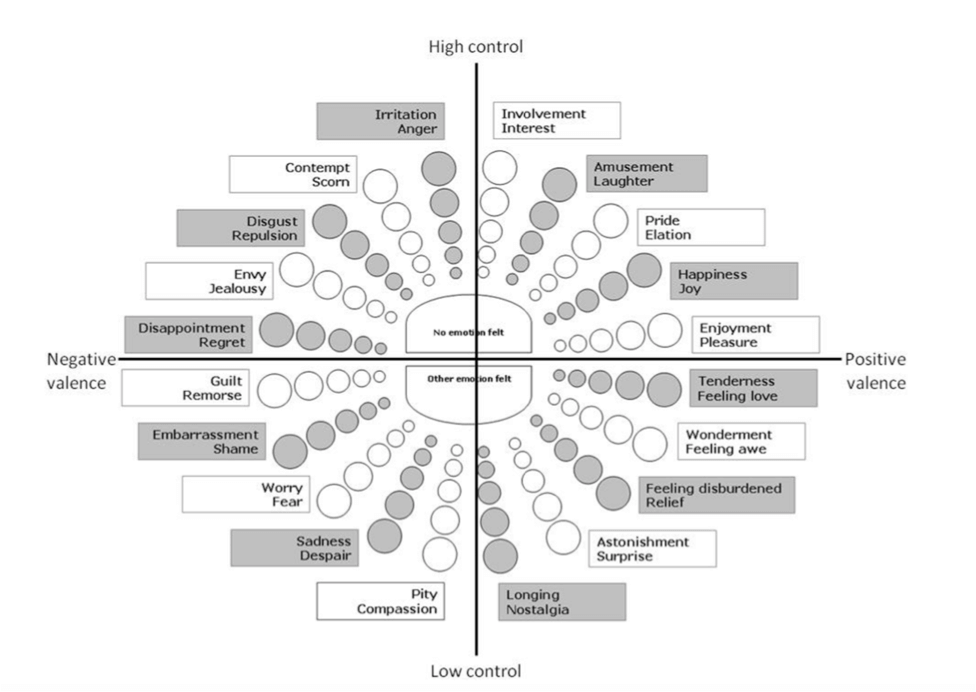
For example, suppose you’d like to better understand your client’s baseline emotional state on an average day. In that case, you could ask them to complete an emotion wheel as part of a standardized set of intake materials.
Alternatively, perhaps if your client has a mood disorder or experiences rapid fluctuations in emotions, you can invite them to complete emotion wheels as a form of reflection following emotionally heightened events throughout their day.
For a useful tool to facilitate either approach, check out the digital e-therapy app Quenza . The platform provides a simple way for helping professionals design and share reflection activities, questionnaires, and more, all using a simple drag-and-drop builder.
Among the various items you can include in your activities is a ‘wheel,’ which can be labeled with emotions according to one of the frameworks we have explored.
When completing your wheel activity, clients can provide ratings (e.g., regarding the intensity or frequency of that emotion) for each wedge of the wheel. Counselors can then use the final result, which looks like a spider chart, to facilitate discussion and reflection.
This is just one of the useful tools in Quenza that can be customized to help your clients learn about their emotions. If you’d like to learn more about Quenza and its functions, check out this psychoeducation interventions case study article or consider taking advantage of the platform’s risk-free 30-day trial .
Human development goes through phases of self-awareness . Here is a great video that explains in detail why understanding what we feel is so important.
As Dr. Watkins explained, most individuals stay stuck in the consciousness state of a nine-year-old, due to the set of rules that the educational system, the society, and the corporate world impose. How bizarre is that?
When a crisis enters our lives (or another intense event), we start asking more questions about the role we play in the world. We start paying attention to the emotions and the messages they send to themselves and others.
When people are ready to face their negative or positive emotions, the inability to verbalize makes this developmental process difficult. When in distress, utilizing these emotional tools helps us establish a plan of action.
As a first step, individuals can examine their emotions, understand what events and stimuli activate certain emotions for them, and the outcomes that tend to follow. For example, before a dinner party or similar social event, a human might feel “apprehensive” because they want to feel like they belong to a particular group. By understanding and labeling this emotion, the person might be less hard on themselves for feeling a bit nervous.
Emotions influence our health, performance, wellbeing, motivation, sense of fulfillment, and decision-making skills. It’s important to understand and manage them.
When people don’t understand their current emotion, they may panic as their internal locus of control leaves them in disillusionment. This is natural, hence the importance of recognizing our feelings. As a review, individuals with an internal locus of control believe that,
“events in one’s life, whether good or bad, are caused by controllable factors such as one’s attitude, preparation, and effort” (Grinnell, 2016).
Wheels in Counseling
These tools are valuable for individuals in counseling sessions as one way to pinpoint the exact emotion (from a list of many) and understand how the emotion was created. Such answers can provide clarity and guidance towards solutions, rather than a fixation on the problems that caused the dilemma or intense feelings.
Below is the chart of the combinations one can have when mixing the primary emotions (Anderson, 2017).
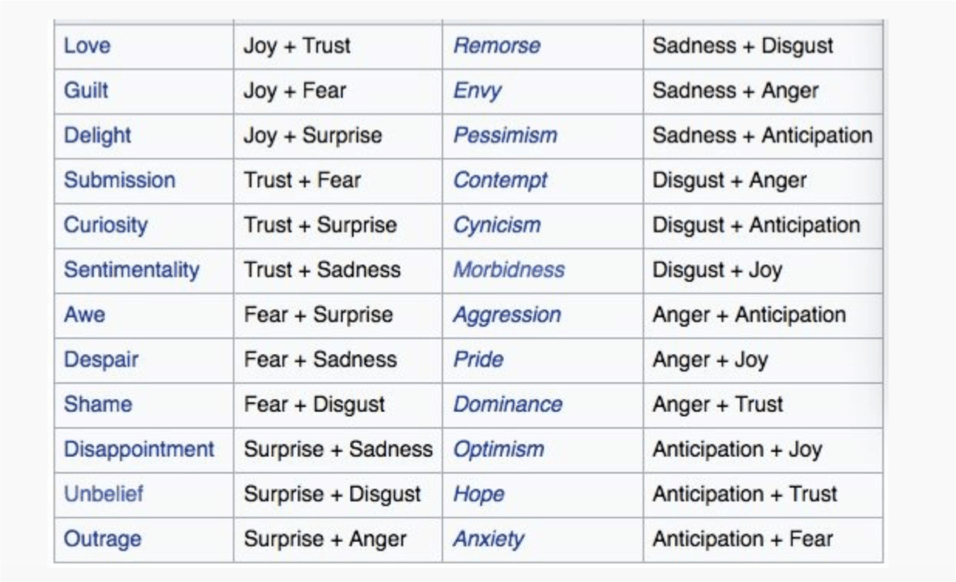
That’s where the tool comes in. It helps in the following four ways:
1. Simplifies emotions
Walking around with a mind full of confusion and uncertainty can make anyone feel sad or overwhelmed. This is especially true of clients and individuals who want to understand themselves or a stressful situation, but don’t know where to start. With a wheel of emotions, the client can browse the various emotions and pinpoint the specific ones they’re experiencing.
2. Outlines the personal sequential model
By examining the primary emotions, one can start to consider what sparks the stimuli, how the emotion is expressed (it’s physical and mental aspects), and the actions it propels one to take.
By drafting one’s own chart of stimuli events, cognitive appraisal, subjective reaction, behavioral reaction, and function, an individual can become more aware of their habits and behaviors.
Maintaining a journal of emotions, where one writes about what they felt throughout the day and what caused it, is a great way to incorporate reflection with this tool.
3. Provides an opportunity for sharing
When someone shares their emotions and deep internal feelings with another, it creates an environment of trust and openness.
By sharing, the client can open up and initiate propulsion for change and self-improvement. It also helps create a positive rapport between the client and counselor or therapist.
4. Empowers individuals
Being attuned with what one is feeling (and therefore doing) can be empowering. Instead of trying to suppress, reject, or ignore emotions, people learn how to express and share them in a constructive way, as well as analyze the role they play in one’s life.
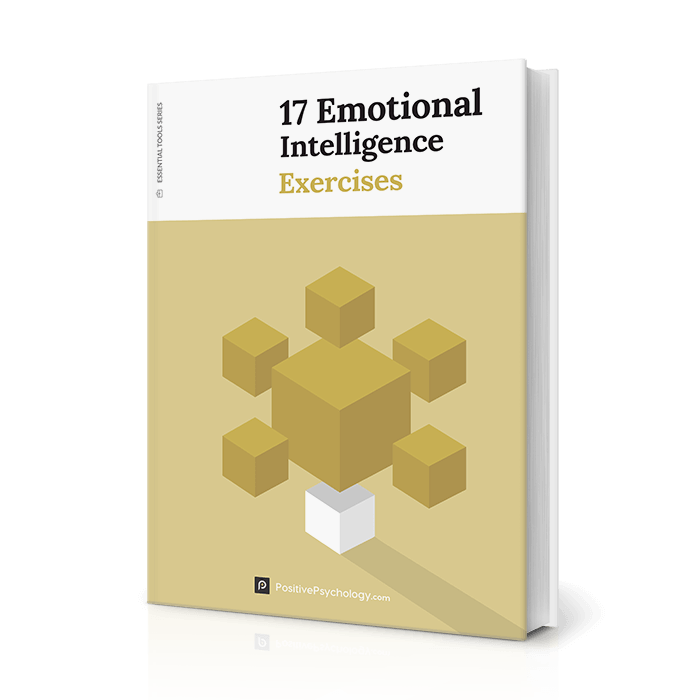
17 Exercises To Develop Emotional Intelligence
These 17 Emotional Intelligence Exercises [PDF] will help others strengthen their relationships, lower stress, and enhance their wellbeing through improved EQ.
Created by Experts. 100% Science-based.
A Fun Test Using Plutchik’s Wheel of Emotions: Who Are You Really According to the Emotion Wheel?
Those who are curious to see what their emotions reveal about them, and how it influences their personality can take any one of these emotional intelligence tests .
The knowledge one walks away with, about the self, gives clarity and understanding, which is essential for development and growth. It expands one’s cognition, which is crucial in our judgment, problem-solving, higher-level thinking, planning, imagination, perception, and more.
“the main way in which cognitions and emotions are linked is through appraisals. When anything happens, we evaluate what it means for us, its significance to us – this is an emotional appraisal, or an appraisal that leads to an emotional reaction. These appraisals are believed to help us in making fine distinctions about our emotional experiences or in determining the extent or the intensity of the emotion.”
(Ogelk, 2017).
The next time one is experiencing certain emotions (which is an energy in motion), the individual has the ability to utilize all their gathered information, and self-knowledge, to find the path towards the outcomes they desire.
Those wishing to expand their knowledge of emotions can take a look at these further resources, including a video explaining why suppressing emotions is a bad idea.
Worksheets for Children
There are several tools that can help children understand their emotions. With the release of Pixar’s animated movie, Inside Out, which focuses on the emotions we feel within us, there are many materials available to start such conversations with younger kids.
These tools include worksheets like board games, a memory journal, and ideas for kids to draw and share their feelings with parents, teachers, and other caregivers (Mehlomakulu, 2015). You will find a wealth of these tools in our article Is Emotional Intelligence Relevant for Kids?
An Animated Video about Emotions
This video explains why trying to suppress or ignore emotions can lead to many more problems than solutions. While it’s true that there are more negative emotions (shame, fear, sadness, anger, disgust) than positive ones (happiness, surprise/interest), both are vital for our survival.
That’s because our real emotions help us get what we really want. And by listening to the emotions we’ve been carrying around, but have been ignoring, we can release the stagnant ones and make room for new ones.
The main takeaways from the above video help summarize the usefulness and application of Plutchik’s Wheel of Emotions, as well as other similar tools.
These golden rules are:
- Learn to attend to your emotions
- Become curious and patient with your emotions
- Talk about them and show your real emotions to others
- Learn to accept having different emotions
- Change your emotions with other emotions
With the wheel of emotions and these golden rules in hand, life can become more manageable. Imagine a world where everyone had the language to pinpoint an emotion, and understand what they felt. It would help communication in every field.
Do you use the wheel of emotions in your practice or daily life? If so, we would love to hear from you in our comments section below.
For further reading, please see the following five articles on emotional intelligence:
- The Importance of Emotional Intelligence
- How To Improve Emotional Intelligence Through Training
- Emotional Intelligence and Leadership Effectiveness + 69 Exercises
- Teaching Emotional Intelligence to Teens and Students
- Emotional Intelligence Skills and How to Develop Them
If you’re looking to help your clients become more emotionally intelligent by sharing online exercises and tools with them, the new Quenza application will help you do exactly that.
We hope you enjoyed reading this article. Don’t forget to download our three Emotional Intelligence Exercises for free .
- Affective Sciences. (2017, September 27). The Geneva Emotion Wheel – CISA – UNIGE. Retrieved from http://www.affective-sciences.org/gew
- Anderson, J. (2017, March 26). Dyad & Compound Emotions. Retrieved from https://gatehealing.com/dyad-compound-emotions/
- Changing Minds. (2016). Plutchik’s Ten Postulates. Retrieved from http://changingminds.org/explanations/evolution/plutchnik_postulates.htm
- Complete Coherence. (2017). Universe of Emotions . Retrieved from http://www.complete-coherence.com/universeofemotions/
- Cowen, A. S., & Keltner, D. (2017). Self-report captures 27 distinct categories of emotion bridged by continuous gradients. Proceedings of the national academy of sciences , 114(38), E7900-E7909.
- Emotion Researcher. (2015, March). The Component Process Model of Emotion, and the Power of Coincidences | Emotion Researcher. Retrieved from http://emotionresearcher.com/the-component-process-model-of-emotion-and-the-power-of-coincidences/
- Grinnell, R. (2016, June 17). Internal Locus of Control. Retrieved from https://psychcentral.com/encyclopedia/internal-locus-of-control/’
- Kircanski, K., Lieberman, M. D., & Craske, M. G. (2012). Feelings into words: Contributions of language to exposure therapy. Psychological Science, 23(10) , 1086-1091.
- Krohn, M. (2007). Robert Plutchik’s Psychoevolutionary Theory of Basic Emotions. Retrieved fromhttps://dragonscanbebeaten.files.wordpress.com/2010/06/robert-plutchiks-psychoevolutionary-theory-of-basic-emotions-poster.pdf
- Mehlomakulu, C. (2015, July 18). Using “Inside Out” to Explore Emotions. Retrieved from http://creativityintherapy.com/2015/07/using-inside-out-to-explore-emotions/
- Minter, A. (2014, February 26). What Is The Feeling Wheel? Retrieved from http://www.passionprovokers.com/blog/why-use-a-feeling-wheel
- Ogelk. (2017). Emotion Cognition Motivation. Retrieved from http://www.ogelk.net/dersnot/tip/Emotion_cognition_motivation.pdf
- Pekrun, R., & Linnenbrink-Garcia, L. (2014). International Handbook of Emotions in Education , Chapter 2: Concepts and Structures of Emotions.
- Pico, I. (2016, March 23). The Wheel of Emotions, by Robert Plutchik | PsicoPico. Retrieved from http://psicopico.com/en/la-rueda-las-emociones-robert-plutchik/
- Pollack, D. (2015, November 12). Plutchik’s Wheel of Emotions Cheat Sheet. Retrieved from https://www.cheatography.com/davidpol/cheat-sheets/plutchik-s-wheel-of-emotions/pdf/
- Roeckelein, J. (2006). Elsevier’s Dictionary of Psychological Theories.
- Sacharin, V., Schlegel, K., & Scherer, K. (2012, August 13). Geneva Emotion Wheel Rating Study. Retrieved from http://www.affective-sciences.org/files/4514/6720/4016/Geneva_Emotion_Wheel_Rating_Study_Report_2012_08_11_2.0.pdf
- Salovey, P., & Mayer, J. D. (1990). Emotional intelligence. Imagination, Cognition and Personality, 9(3) , 185-211.
- Screenr. (2017). Plutchik’s Wheel of Emotions: How Does It Work, and How Can It Be Applied? – Book Chapter Overview. u3083644. Retrieved from https://www.screenr.com/ZVDN
- Watkins, A. (2014, October 29). How Controlling Your Emotional Responses Can Improve Your Performance at Work. Retrieved from https://trainingmag.com/how-controlling-your-emotional-responses-can-improve-your-performance-work
- Willcox, G. (1982). The feeling wheel: A tool for expanding awareness of emotions and increasing spontaneity and intimacy. Transactional Analysis Journal, 12(4) , 274-276.
Share this article:
Article feedback
What our readers think.
nice jobs thx
Great content. Weird that you do not mention Russell’s Circumplex model as the inspiration and basis of Plutchik’s emotion wheel?
I liked the links to academic papers, it approved me that this text is scientific, and at the same time showed me many connections to other concepts. However I would like to make more connections between Paul Aikman’s feelings wheel and MBTI. I wonder if there are any scientific papers showing a relation between “understanding the world”-“taking decisions” in MBTI and wheel of feelings.
Thank you very much. Calmed me down the moment I started to read this.
A key component seems to be the addition of high activation (characteristic of rage). This makes hatred different from loathing as you can loathe something without it being a physiologically activating experience.
We have a nine-year-old with big feelings, which has prompted us to explore how to navigate feelings more intentionally. We homeschool, and are using aspects of this article to help all three of our children in better understanding of themselves (and us parents as well). Making our own illustration of the chart for the wall! Thank you for sharing this life-changing stuff!
Just curious. What ever happened to HATRED? Hatred is a very angry emotional response towards certain people or ideas, usually related to disliking something. Hatred is often associated with intense feelings of anger, contempt, and disgust. Hatred is sometimes seen as the opposite of love. For such a commonly identified emotion, I do not see it in any of these charts.
Hi Dr. Cavanaugh,
That’s a great question! I’m not an emotions researcher, so I can’t give you a definitive answer. But my sense is that hatred lies somewhere between loathing and rage. A key component seems to be the addition of high activation (characteristic of rage). This makes hatred different from loathing as you can loathe something without it being a physiologically activating experience. Like I can loathe brussels sprouts without getting fired up at the thought of them.
This would be my best guess 🙂
– Nicole | Community Manager
Lovely read…helped me design a food menu
A client of mine is writing an article and found the image of the emotion wheel in this piece ( https://positivepsychology.com/emotion-wheel/ ) very useful. I was wondering if we’d be able to use the image in our piece and credit this article? Also, are you the original creators of this image?
Thank you so much for your help and guidance!
Hi Madison,
Yes, we created this image based on Plutchik’s model. You’re welcome to use this image for research purposes provided you include a citation linking to this article. If you’d like to republish it for commercial purposes, please drop an email to [email protected] letting us know a few details about your business and how you intend to use it. You can also find a version of this image free for public use in Wikimedia Commons .
Hope this helps!
Sounds great, thanks so much for your help!
I LOVE THIS WEBSITE, thanks for writters who contribute the knowledge, with more detail about it, thank you….
Let us know your thoughts Cancel reply
Your email address will not be published.
Save my name, email, and website in this browser for the next time I comment.
Related articles

Understanding the Cannon–Bard Theory of Emotion: 3 Examples
We describe ourselves as seeing red when angry, turning green with disgust, or flustered when excited. But how do we define emotions, comprehend their cognitive [...]

What Is Emotional Awareness? 6 Worksheets to Develop EI
Many argue that emotional intelligence (EI) is more important than traditional intelligence, boosting academic and career success, leadership skills, and mental and physical wellbeing (Larsen, [...]

Positive Intelligence: How to Overcome Saboteurs in Coaching
Positive intelligence has become a popular term in the executive coaching world. It is the new ‘intelligence’ of this decade, just as emotional intelligence was [...]
Read other articles by their category
- Body & Brain (48)
- Coaching & Application (57)
- Compassion (26)
- Counseling (51)
- Emotional Intelligence (24)
- Gratitude (18)
- Grief & Bereavement (21)
- Happiness & SWB (40)
- Meaning & Values (26)
- Meditation (20)
- Mindfulness (45)
- Motivation & Goals (45)
- Optimism & Mindset (34)
- Positive CBT (28)
- Positive Communication (20)
- Positive Education (47)
- Positive Emotions (32)
- Positive Leadership (17)
- Positive Parenting (2)
- Positive Psychology (33)
- Positive Workplace (37)
- Productivity (16)
- Relationships (47)
- Resilience & Coping (35)
- Self Awareness (21)
- Self Esteem (37)
- Strengths & Virtues (30)
- Stress & Burnout Prevention (34)
- Theory & Books (46)
- Therapy Exercises (37)
- Types of Therapy (64)
3 Emotional Intelligence Exercises (PDF)
Subscribe to our newsletter
The Inspired Treehouse
Growing healthy bodies and minds through play!
Free Printable Emotional Regulation Activities for Kids
July 14, 2023 By Claire Heffron
You’ll definitely want to add this fun worksheet to your toolbox of emotional regulation activities for kids!
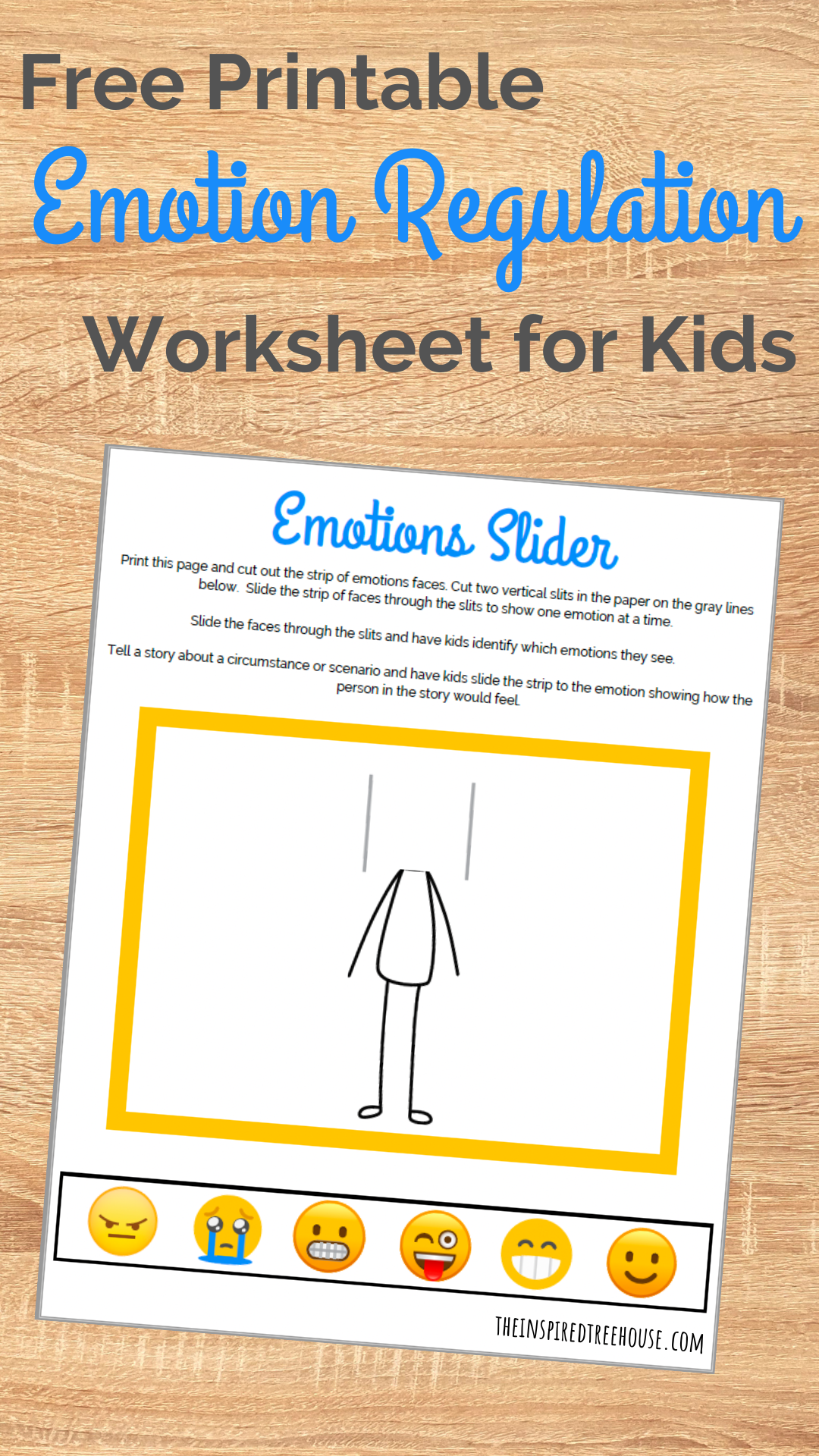
This post contains affiliate links. Read more.
Emotional Regulation Activities for Kids
Before you can dive into self regulation strategies for kids, it can be helpful to rewind and start with the basics. In order for kids to be able to participate in emotional regulation activities, regulate their emotions, and generate healthy emotional responses to challenging circumstances in their everyday lives, it’s important for them to demonstrate understanding of different emotions in themselves and others. We often find that, as kids start talking about emotions, the floodgates open and suddenly you can get into much deeper conversations about life’s challenges, feelings, and how we can find healthy and appropriate ways of sharing and demonstrating our feelings in various settings. One of our favorite free printable emotion regulation worksheets allows kids to practice this skill by listening to short narratives and then using manipulatives to try to identify how the person in the narrative might be feeling. We also love this awesome emotions in-hand manipulation and hand strength activity using putty!
The Self-Regulation Handbook
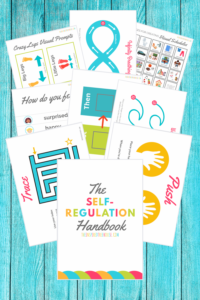
If you’re looking for more self-regulation strategies, resources, and printables – you won’t want to miss our Self-Regulation Handbook . The downloadable resource is packed with pro tips, expert strategies, & tried-and-true tools to support self-regulation so kids can learn, grow, & succeed! If you are overwhelmed by behavior challenges in your classroom or therapy sessions… If you are frustrated with your child’s behavior at home… If you are working with kids who need help with… -Listening and paying attention in the classroom -Following directions -Interacting with peers and adults -Transitioning between activities -Tantrums or meltdowns -Calming their brains and bodies -Problem-solving and flexible thinking -Understanding and processing emotions This is the resource for you! CLICK HERE TO LEARN MORE!
Free Printable Emotional Regulation Worksheet
Today’s emotional regulation worksheet has a similar focus, but uses an even simpler hands-on method for demonstrating an understanding of emotions. All you need is some very simple materials to get started.
What You’ll Need:
-Free printable emotional regulation worksheet (scroll down to find the form)
What to Do:
Print the worksheet and have kids cut out the strip at the bottom with the emotions faces. Help the child fold the paper in order to cut the two gray lines to create the slits to slide the strip through. Place the strip of faces behind the piece of paper and slide it from the back through one slit and then the other slit so the faces show on the front of the paper. Tell a story about a common circumstance or scenario (e.g. a child who loses a favorite toy, a child whose classmate cuts in front of him in line, a child who is having a birthday party) and have kids slide the strip to the face showing the emotion that the person in the story would feel.
How to Change it Up:
-To make the emotions strip easier to grasp, try punching holes and tying a short piece of string or yarn to each end. -Use the finished worksheet as one of your self-regulation strategies for kids in your therapy room or classroom . Can kids use the page to identify how they’re feeling if they are unable to verbalize their emotions? -Pair this activity with some of the best feelings books for kids ! -Try some of our favorite self regulation games and activities – perfect for therapy, home, or the classroom! -Looking for other emotional regulation activities ? We’ve got you covered! -And, find all of our best emotional regulation activities and self-regulation strategies in The Self-Regulation Handbook! -Looking for more free printable emotion regulation worksheets ? Check out Coping Skills for Kids and all of the great resources there from our friend, Janine Halloran!

- Latest Posts
Claire Heffron
Latest posts by claire heffron ( see all ).
- Fairy Tales Games: Gross Motor Obstacle Course - April 4, 2024
- 10 Outdoor Therapy Activities for PTs and OTs - March 31, 2024
- Gross Motor Digital Interactive Games for Kids - March 12, 2024
Privacy Overview
Pin it on pinterest.
Parent Press
a Goally Publication
Managing Emotions Worksheet | Free Printable
Home » Parent Press » Products » Printables » Emotional Regulation Charts » Managing Emotions Worksheet | Free Printable
Feelings are a natural part of life, but helping your kids navigate their emotions can be challenging. As parents, it’s your duty to guide them through this process. Our printable managing emotions worksheet is a helpful tool. It aids kids in understanding and expressing their emotions, recognizing them, and developing coping strategies. This blog post discusses the importance of emotion management for kids, backed by research, and provides effective strategies for nurturing emotional competence.
Table of Contents
Emotion Management: Why It Matters
The importance of emotional management in children, especially around the ages of 2-12, shouldn’t be underestimated. For example, developing emotional skills as a youngster plays a crucial role in forming positive relationships with peers, managing stress , and navigating complex mental landscapes.
Above all, mastering these skills can lay the groundwork for a lifetime of mental health stability. Numerous research studies back up the significance of emotional literacy and education in children.
Meanwhile, ignoring emotional management may lead to behavioral issues , academic struggles, or even mental health conditions. So, guiding our kids to manage emotions effectively is a must.

Strategies for Emotional Management
- Identify emotions : Kids need to name what they feel before they can manage it. This is where our printable managing emotions worksheet does wonders. It helps kids identify, express, and understand their emotions.
- Promote empathy: Developing empathy is crucial in managing emotions. It helps children understand and respect the feelings of others, teaching them how their actions affect those around them.
- Practice coping strategies: Teaching our kids coping strategies like deep breathing exercises, physical activities, and creative expression can assist in managing overwhelmingly intense emotions.
- Maintain a supportive environment: Provide a safe space for kids to express their feelings. It helps them know it’s alright to have and express emotions.
How to Recognize Emotions
Minute observations can reveal so much. Kids may be unable to express their feelings like adults, but their expressions, body language, and behavior can be loud. A furrowed brow may signal worry; a lack of appetite could indicate stress. Most importantly, resist the urge to dismiss their feelings. Instead, acknowledge them, in other words, validate their emotions. It lays the foundation for trust and open communication.
Coping Mechanisms for Different Emotions
Every kid is unique, so should be the coping mechanisms . One-size-fits-all doesn’t work, and it’s okay. Trial and error are part of this journey. What helps one child might not work for another; however, the crucial thing is to help them discover what works for them. Launch a journey of emotional exploration together, preparing them for life’s emotional roller coaster.
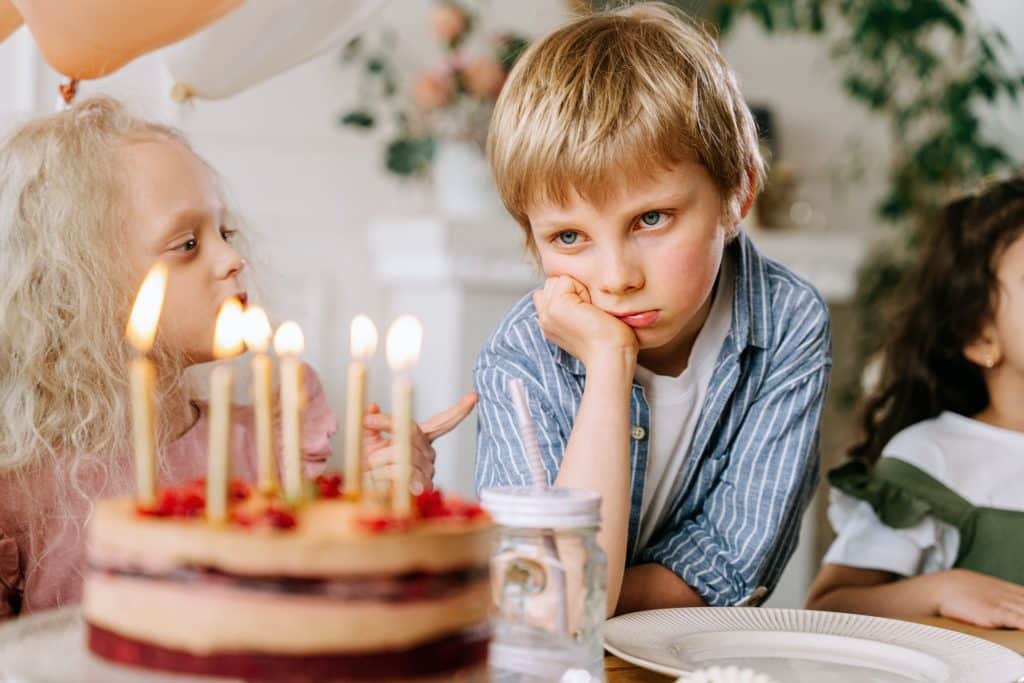
Essential Tips for Parents
Remember that every child is unique, including neurodivergent kids or kids with special needs. Therefore, your strategies for one child might require tweaking to be effective for another. More importantly, remember, as parents, your reaction to your child’s emotions plays a key role in developing their emotional intelligence . Above all, show empathy, patience, and understanding despite the emotions displayed.
The Managing Emotions Worksheet
Equipped with understanding and strategies, it’s time to steer the emotion-ship. Our tailored managing emotions worksheet is an essential tool for putting all the above strategies into action. Use it as your compass to navigate the complexity of feelings, guide conversations, and help your child grow emotionally. After that, the bonus? It’s printable and will serve as a ready reckoner whenever needed.
Tired of Emotional Meltdowns?
Goally’s Mood Tuner app has activities for kids with BIG emotions. Teach kids how to tune their mood with Goally. See fewer meltdowns.
The Mood Tuner app encourages kids to look inwards and identify their feelings, helping them understand what’s going on inside. Once they’ve recognized their emotions, they can choose from a 20+ activities designed to help them self-regulate and find their balance.

The road to emotional competency can be bumpy and filled with surprises, yet it’s worth every effort. Our printable managing emotions worksheet offers a practical solution for guiding your kids to be the captains of their emotional seas. While managing emotions can be as fickle as the sea, with consistent practice and both of you on board, your kids can learn to navigate these waters successfully. The journey may seem daunting right now, but in supporting your child’s emotional competence, you set the course for smoother sailing ahead.
FAQ about Managing Emotions Worksheet
Company info
Media requests
Our Services
Terms Of use
Privacy Policy
Our Website
Neurodiversopedia
Privacy Overview
- Free Printables Worksheets and Activities
- How to Download for FREE
- Preschool teacher posts
- All Preschool Themes
- Elementary teacher posts
- Free Printables
Emotions Printable
Printables and activities on feelings and emotions.
These activities are particularly valuable as children are learning to recognise and regulate their own feelings and emotions, as well as learning to recognise and empathise with the emotions of others.
Emotions Printables Worksheets and Activities
Join Teachers Mag to connect and share ideas to improve teaching & learning! About Us
Join Us and Start Blogging!
★ Sign Up ★ Log In
- Spring Theme
- Plant Theme
- Flower Theme
- Insects Theme
- Dinosaurs worksheets
JOIN ♥ TeachersMag NOW and Add Your Own Posts! You can share your ideas, articles, and photos of your crafts done by you and your students, or just blogging about your working day!!

18 Mindful Eating Exercises + a Free Worksheet
A re you trying to live a healthier life? Mindful eating is something you may want to think about, and our mindful eating worksheet (pdf printable) is the perfect tool to help you get started.
What is mindful eating?
Mindful eating means using intention and mindfulness to give your complete attention to the the experience of eating. This means–
- eating slowly and without distractions
- listening to your body, and eating only until you’re full
- paying attention to what triggers eating — true hunger, boredom, emotions, etc.
- using all of your senses when eating–noticing the colors, textures, smells, sounds, and flavors of your food
- learning to appreciate and enjoy your food
- noticing the effects food has on your feelings (anxiety, comfort, guilt, etc.)
- learning to eat for your health
Contrast this with the mindless eating many of us do when we’re in a hurry or snacking mindlessly in front of the television.
Why exercise mindful eating?
Eating is often done on-the-go, our food choices aren’t always the best or most nutritious, and as mentioned above, much of our eating is done in front of the television or computer.
When we eat this way, we tend to eat unhealthy foods, we eat quickly, and we overeat. Since it can take our brains up to 20 minutes to send us the signal that we’re actually full, by then we’ve eaten way too much.
When we eat mindfully, our attention is where it belongs. Eating becomes intentional, we eat when we are hungry (not out of habit or boredom), and we actually enjoy our meals much more!
It’s empowering to put yourself in control of your eating habits. Many people find they lose weight when they practice mindful eating too, as their behaviors change and their stress related to food is reduced.
Are you ready to give mindful eating a try? Print our mindful eating worksheet as a reminder. A good place to keep this sheet is on your refrigerator or kitchen table.
Click here to print your mindful eating worksheet pdf .
This will print on an 8½” x 11″ sheet of paper, or use your printer’s settings to size it to fit your page.
___________________
You might also like —
Self-Care Checklist Printable (Free)
30 Stress-Relief Adult Coloring Books — The Perfect Way to Unwind and Lower Anxiety
Glow Up Challenge + 5 Pages of Printables, Including Daily Trackers to Keep You Motivated
18 Mindful Eating Exercises + a Free Worksheet PDF first appeared on MomsWhoSave.com .


IMAGES
COMMENTS
worksheet. Emotions can creep up on us. What starts as hungry, tired, and frustrated can grow into something bigger, like a blackout rage. Or an unexplained feeling of excitement might be the forewarning of a manic episode. By understanding what an emotion feels like at its earliest stages, clients can learn to respond before it grows out of ...
Welcome to the feelings and emotions section of the site. There are currently 301 worksheets available on this topic; they are free and easy to print out to use in your classroom.This feelings & emotions worksheet uses an amusing character to illustrate thirty different emotions. You can use this as an introduction, a study sheet, a poster, and even adapt it to make your own matching worksheet ...
These free printable feelings worksheets are a handy tool. Children can color the picture of a child expressing the featured emotion and trace the words in this identifying emotions worksheet. This emotions worksheet set is handy for preschool, pre-k, kindergarten, and first grade students. Simply print feelings and emotions worksheets and you ...
Help children identify and make sense of their feelings and emotions with this printable My Emotions Activity Pack. Featuring an emotions chart, feelings mini book, emotions puzzles, three part vocabulary cards, feelings puppets and much more. Shop TPT. Add this fun Emotions sensory bin to your classroom activities.
Use these printable worksheets and games for teaching students about basic emotions and feelings. Feelings included in these activities: happy, sad, angry, tired, and afraid. Grades K through 2
This first feelings worksheet is great for introducing the names of feelings and emotions in English. There are 10 feelings on this worksheet including happy, sad, angry, hungry, thirsty, bored, tired, cold, scared, and sick. To complete the worksheet, students should look at the picture and then circle the correct feeling/emotion word.
Emotions and feelings worksheets provide children with tools for coping with stress or overwhelming feelings in a healthy manner instead of resorting to harmful behaviors like aggression or withdrawal. Support overall well-being. Promote mindfulness practices. Related: Interactive 4-Year-Old Chore Chart.
worksheet. Pinning down the word that perfectly describes a feeling can be difficult, even for adults. Developing emotional intelligence requires experience and introspection, but a basic vocabulary comes first. We created the Emotion Faces printout to help children match a word (and a face) with their feelings.
This printout is just that. The 57 emotions listed in this worksheet range from basic (e.g., happiness, sadness) to complex (e.g., inadequate, disdain). It can be helpful to have one of these worksheets handy when you're working with clients who have difficulty verbalizing how they feel.
Emotions Worksheets 2024. Our practical Emotions Worksheet collections are designed to help kids in understanding the several emotions they could experience in varying situations. In the resource, students are asked to explain their choice of activity and how it relates to the provided feelings.
These worksheets will start by helping students identify emotions of others through facial expressions and a mood or tone that they can observe. We then move on to explore our own feelings by trying to understand how the action of others affects us. We encourage students to write about their experiences in a personal setting.
This worksheet consists of 6 different faces. The faces are blank, but underneath each face is a written emotion: "I'm sad", "I'm afraid", "I'm happy", etc." . This emotions worksheet consists of two parts: In each blank face, draw what you think the below emotion looks like.
The emotions students feel in the classroom greatly impact their learning potential. With social-emotional worksheets, your child explores mindfulness, builds self-awareness, and learns to self-soothe. Social-emotional worksheets include deep relaxation pages, weather reports, feeling cards, and more. Use these sheets in your home or to help ...
Printable emotion cards for adults can even come in handy when you are dealing with special needs. Free Feelings and Emotions Printables: We have done the legwork of searching for printable emotions worksheets, face emotion cards, a feelings chart for kids, and feelings games that you can use to teach coping skills.
The Printable Emotion Faces worksheet helps children in therapy understand and claim their feelings healthily. About This Worksheet. Providing a visual aid when learning about emotions can help kids in therapy who are struggling with emotional and behavioral challenges. It is a fun way to learn about different emotions and how to express what ...
K5 Learning offers free worksheets, flashcards and inexpensive workbooks for kids in kindergarten to grade 5. Become a member to access additional content and skip ads. Students relate facial expressions to feelings and emotions.
8 Emotional Regulation Worksheets & Emotion Pictures. Aside from the strategies and techniques listed above, there are also several helpful handouts, worksheets, and even images that can aid you in developing your DBT skills and improving your emotion regulation. ... Print an image of a traffic light, and help the small children in your life ...
The Basic Emotions handout lists four basic emotions that are commonly discussed in therapy—happiness, sadness, fear, and anger—alongside their related complex emotions. This simple worksheet may be helpful in many different scenarios: When a client struggles to associate a feeling with an experience, this handout provides a simple list of ...
2 Emotion Wheel Worksheets. To tap deeper into the mind and get to the root cause of these internal emotions, here are several worksheets to assist through the process: Clear and brief: emotions Provides a snapshot view of emotions, and the way they are trigged in the mind. Outlines the developmental levels our emotions grow through.
What to Do: Print the worksheet and have kids cut out the strip at the bottom with the emotions faces. Help the child fold the paper in order to cut the two gray lines to create the slits to slide the strip through. Place the strip of faces behind the piece of paper and slide it from the back through one slit and then the other slit so the ...
Our printable managing emotions worksheet is a helpful tool. It aids kids in understanding and expressing their emotions, recognizing them, and developing coping strategies. This blog post discusses the importance of emotion management for kids, backed by research, and provides effective strategies for nurturing emotional competence. ...
Emotions Printable Printables and Activities on Feelings and Emotions. These activities are particularly valuable as children are learning to recognise and regulate their own feelings and emotions, as well as learning to recognise and empathise with the emotions of others. All About Me Theme. Emotions Printables Worksheets and Activities. Total: 13
Click here to print your mindful eating worksheet pdf. This will print on an 8½" x 11″ sheet of paper, or use your printer's settings to size it to fit your page. You might also like —
worksheet. Plutchik's wheel of emotions identifies 8 basic emotions including joy, trust, fear, surprise, disgust, anger, and anticipation. Combinations of these basic emotions result in advanced emotions, such as optimism, love, submission, awe, disappointment, remorse, contempt, and aggression. This Wheel of Emotions diagram beautifully ...